At EAG: London 2024, I presented Ambitious Impact's strategic vision for maximizing career impact across the EA ecosystem. I introduced the concept of "high absorbency" careers and outlined why and how EA should create more targeted on-ramps, helping promising individuals bridge the final gap to truly impactful roles. I also reviewed AIM's expanded program offerings, each tailored to address specific bottlenecks within their respective ecosystems. Here’s a transcript of the talk, relevant for individuals looking for high-impact careers, EA organizations, and EA as a movement.
Edit: I ended up giving the same talk filmed at EAGxVirtual so you can also watch/listen to the talk now here.
Key Points:
- The talk emphasizes the need for structured guidance to help people transition into high-impact careers, especially those who are already skilled but face last-mile barriers. Building on-ramps for people who are 95% of the way to impact is thus a uniquely effective way to solve talent bottlenecks.
- Absorbency (i.e. the number of people who can realistically and successfully get a type of job) is an underappreciated consideration for EAs looking to build the spaces within which individuals can have an impact with their careers.
Thank you to Habiba, who generously served as an MC for this talk.
Why we need on-ramps & what they are
In this talk I'm going to talk briefly about on-ramps; what they are, why we need them, and why they're valuable. Then I’ll talk about a few concrete examples, specifically what Ambitious Impact is doing as well as some gaps of where I think other on-ramps can be created for high impact career paths. Then, we'll talk about applying this framework a bit more broadly to the world; what to do if you’re an individual, what to do if you're associated with an EA organization, and what to do as a movement to make this whole thing result in more people having high impact career paths.
The problem: skills gap creating talent bottlenecks
So the problem is, we have some really talented, wonderful people who want to have a really high impact career, but they don't always get there. You can model here the guy with the question mark as someone who studied philosophy and is going through a small existential crisis, and the guy holding the gear as someone with a quant degree who doesn't know what the heck to do with it. So we have these people, they're great, they want to make a big difference. And we want to get them over to the other side of the map here where they think about light bulbs all the time as the Effective Altruism movement likes to do.
Between there are a small series of steps that people need to go through, you can model it as a staircase, as we have here. Each of these steps can be intimidating, scary, and worrying. Often, there's multiple steps between where you start off wanting to make a difference, and where you actually get into one of these brilliantly impactful career paths.
The solution: building on-ramps to help people reach career goals
I'm proposing that we should create on-ramps. The on-ramp is represented by the very complex triangle, and the individuals have now been simplified into a well rounded circle. We're trying to get the circle up the staircase, we're trying to build on-ramps, which I'm defining as scalable solutions that make it easier to obtain a certain goal. In this case, the goal being a high impact career path, and the on-ramps being ways to make those jumps or career steps easier, eventually resulting in more people going through that career path.
How to choose where to build on-ramps
Which career paths should we focus on building on-ramps for?
The first question we have to ask here is, what career paths do we actually want to focus on when it comes to building these on-ramps? We have a couple different factors that we can look at, some of which the EA movement already thinks about a lot, and some of which EA typically neglects. To model the total impact of a career path, you can think about the impact per person times the absorbency of the career path. The absorbency of the career path is the thing that I think categorically we tend to neglect or forget about. To illustrate this I’ll use two examples, Charity Entrepreneurship and Founding to Give.
Charity entrepreneurship is a fantastically great and impactful career path, and it generates hundreds of thousands of dollars of impact compared to donating directly to impactful charitable organizations. But fundamentally, it can absorb only a small number of founders. Even though we get thousands of really talented applications, at the end of the day we cannot start thousands of charities.
Meanwhile, Founding to Give might be lower impact; for this hypothetical, we're going to call it $50,000 of impact. But it can absorb a lot more people. We’re saying 500 people in this example, but the for-profit world isn't a bounded thing. We actually could throw a huge chunk of the EA movement towards earning to give and donating money. And that would actually just be great. There would be a lot of benefits and synchronicities of people going into that career path, and it wouldn't get capped out or limited in the same way that nonprofits are.
Calculating the impact of a career
When we think about calculating the impact of a career, we can think about the benchmark of what the person would have done otherwise. Maybe they would have done something pretty impactful while donating, and now they’re switching to something that makes them have even more of an impact. We think about the counterfactuals; how does it trade off for one person to move into a career slot compared to who else would have taken that career.
In some cases, it's pretty clear; with entrepreneurship, sometimes the charity doesn't get started. With other career paths, say becoming a senior researcher at an org that already attracts a lot of talent, it might just be the difference between you and the next best researcher.
Finally, limiting factor. This is something the EA moment thinks a little bit less about; within a given cause area or problem set, what is the actual challenge? Sometimes it's people or talent, in which case getting a career directly involved in that might be really great. Other times the bottleneck might actually be funding; factory farming is a good example of this, where often projects are funding limited, not talent limited.
Calculating absorbency
Calculating absorbency is a newer concept in the EA movement. But we have something very adjacent that we think about a lot; room for more funding when it comes to charitable organizations. Sometimes we see a charity and it's fantastically impactful, but it's tiny, maybe it can only absorb $500,000, or a million dollars. That can be really great, we should still fund that charity. However, a lot of our big hits, the charities that EAs are most excited about, are charities that not only are really cost effective and evidence based, but also have a huge amount of absorbency. So they can handle several millions or 10s of millions of dollars through them. Think of all the top GiveWell recommended charities; they can both absorb a lot of money and hit these very high standards for cost and evidence base.
The same broad concept can actually be applicable to careers. When we think about career paths, often we're looking at it from an individual lens; thinking about what is highest impact for me. But as a collective movement, and as AIM, an organization that works on a variety of career paths, we’ve got to think a little bit more about the number of people that this career path can absorb.
When I'm talking about absorbency, I'm talking about the people that can realistically be absorbed into a field. There could be jobs that theoretically have high absorbency; for example, there are 125 presidents in the world. But practically, that's a very hard position to get, you have to have a very narrow specific set of skills. The career paths that are really high absorbency can not only handle a large volume of people, but also it's practical for a large volume of people to apply and actually get into that sort of career path.
In general, we want to think a lot about this, because as we hopefully have more and more people in our growing Effective Altruism movement, we need to know where to place them, and we don't want to have bottlenecks at different steps in the process. Sometimes the EA movement has been frustrated when there's a whole bunch of EAs that want a particular career path, but it's very, very low absorbency, and then that top path becomes extremely competitive. If we had more high absorbency career paths, and we built on-ramps for those types of high absorbency career paths, that alleviates a lot of the issue.
Example: NGO founding & Charity Entrepreneurship
So we have our problem and our steps. The next thing we need to talk about is the destination, and I've put an excellent, pirate-map style X to mark where the heck we're going.
In this case, the destination is trying to be reached by a heck of a lot of people. It's not just one person on the map, there's a whole bunch of people all at different steps, and probably about half of them or less are pirates. But otherwise, they're various distances from achieving this high impact career path. Some are right next to it, some are a lot further away. But let's zoom into the X for a second, let's talk about what the destination is.
The destination is something like creating more Robert Mathers. Rob is a national treasure, he founded the Against Malaria Foundation, which many of you will have heard of. They’ve distributed 257 million long lasting bed nets, and GiveWell estimates they can save a life for $5,500. We know we want to make more Rob Mathers, we know that he's having this brilliant, huge impact in the world.
Lead Exposure Elimination Project as a case study in NGO founding
Rob Mather basically followed the career path of NGO founding, a career path I have no personal stake in or bias to promote whatsoever (irony). He's successfully set up an evidence-based organization that’s scaling a really great intervention. He's not the only example; the Lead Exposure Elimination Project has done a huge amount of good, averting 900,000 DALYs by preventing 50 million people from being exposed to lead.
A weakness of this career path is the absorbency is small. At the end of the day, there's a lot of things that affect how many charities we can actually found beyond the number of founders and people going into the career path. There's funding limitations, there's other talent limitations to building up the ecosystem. There's even idea limitations about how many ideas are out there that are particularly cost effective and conducive for a brand-new charitable organization to start.
So we have the script for what makes a good founder, we know how to find the people, we know how to train them. We know that if someone's really ambitious, results-focused, evidence-based, fast-moving, if they have all these entrepreneurial driving traits, they can have a huge amount of impact in charity entrepreneurship. But fundamentally, there's still a lot of people that aren't doing charity entrepreneurship, or at least weren't doing charity entrepreneurship because of barriers.
On-ramps as last mile solutions
What I'm suggesting is that we make an on-ramp at the very end of the process. It's called the Last Mile Solution. So with charity entrepreneurship, we're trying to think of the people who are really, really close. We're trying to get the people just that last little inch, the people who are 95% of the way to being a great charity founder and get them to being a charity founder.
Interestingly, 95% of the way to being a great charity founder actually doesn't cause that much impact at all. So these last mile solutions are really important. This is in contrast to first mile solutions, which actually the EA movement historically has done a lot. Examples like EA outreach broadly, community chapters, these build up the base of people who eventually will hit these high impact career paths. But there's many, many steps left on the journey before they actually get there. You need a combination of both, but looking at the career ramp as a whole, I do think we're relatively under-invested in last mile solutions.
So we want to build that on-ramp, we want to get those people who are 95% of the way there all on to the next step.
Charity Entrepreneurship to AIM: solving more bottlenecks
That's what our Charity Entrepreneurship program aims to do, get these people who are really damn close. We really aren't bringing someone from zero to 95% of the way there. Often our founders are already very entrepreneurially minded. Often they have a lot of those base traits; sometimes they’re former NGO workers, sometimes they're former entrepreneurs who moved over to the nonprofit sector, we're really not taking someone from zero, we're taking them from 95%. But there's a lot of room for other on-ramps. At some point, once Charity Entrepreneurship has set up this on-ramp, we kind of run out of entrepreneurs. Everybody who's close has already moved up to the x. Then we're faced with a dilemma; what do we do when the people who are 95% of the way there are now 100% of the way there? There are two different solutions.
Building multiple on-ramps; Charity Entrepreneurship's transition to Ambitious Impact
One option is to go a bit further down the career ladder, thinking about how to get those next four people on the next step. But there's another option; we can think about other career paths. And that's part of why we've rebranded from Charity Entrepreneurship to Ambitious Impact.
Ambitious impact is more encompassing, aimed at how to in general find and build on-ramps to multiple high impact career paths, not just charity entrepreneurship.
Other AIM programs
We have other career paths that we think are particularly impactful, and which have that exact same gap that Charity Entrepreneurship filled before; helping people who are really close to having a huge impact, make it to that next step. I’ll go through a couple of them briefly.
AIM Grantmaking
In grantmaking, sometimes people have funding to deploy instead of time, they want to make a huge impact. Surprisingly, there's not a ton of grantmaking training, there's not an MBA program for giving out money. Most people just wing it and learn from other people. There's a few other training courses, but they're not that impact oriented, they're a lot to do with the personal grant maker themselves. We found that there was a gap in the philanthropic sector for people who wanted to know how to do grants better and to improve their methodology.
As a result, we set up this grant making program. It's a good fit for philanthropic organizations, individual grant makers, high-net-worths who all want to give more money effectively. You can already guess the problem with this though; extremely low absorbency. At the end of the day, there's not that many grantmakers who are just starting out and excited to change their pathway dramatically, or that many high-net-worths who are giving a bunch of money and want to fill key ecosystem gaps. This is a great place to build an on-ramp that helps absorb maybe 12 people a year.
AIM Founding to Give
Let's look at Founding to Give. This one's particularly exciting because a lot of people who are considering charity entrepreneurship as a career path are also considering for-profit entrepreneurship as a career path. There's a lot of overlap, it's probably about 75% similar. And unlike our previous two options, this career path actually has extremely high absorbency; we really could send thousands of people.
A characteristic that makes career paths higher absorbency is that they interact with the real world a little bit more, outside of the EA ecosystem. As soon as we start looking at broader career paths, such as Founding to Give or government interventions, or other places where people are ultimately getting employed by an organization outside of the EA bubble, we start getting much higher absorbency numbers.
Founding to Give is actually more like a pre-incubator than an incubator; we want to help people take that first step before applying for something like Y Combinator or a different for-profit incubator. Founding to Give also requires a really high pledge (50% of any earnings above a million). For a for-profit person who's never considered donating this is kind of nuts, but compared to our charity entrepreneurs, they're looking at that going, “that's amazing, you can actually make over a million dollars, no way!” So it depends on your reference class of comparison.
We think Founding to Give could be a really good fit for people with strong entrepreneurial drive, individuals who are looking to make a big difference and have a bit more of that edge of wanting to found something new. In general, it's a good focus for people who might have a bit more of a technical background because that benefits you in for-profits a lot more than it does in nonprofits, or people who are generally a bit more excited about the pitching, communication side of things as opposed to the hard measurement and evaluation side of things.
Effective Giving Incubation
We have a really cool effective giving program. However, applications have already closed, it's already done, you can't apply for it and we might not run it again as the absorbency of the EA movement for new effective giving organizations is relatively low and we want to see how the organizations we launched work out, and identify the latest gaps, if we were to do it again. So I'm not gonna talk about it too much.
AIM Research
We also have a research training program. It’s a less common career path in EA, but we do think that there's potential for people to move up the career ramp in research. In general, there's often a huge number of junior researchers and a very small number of senior researchers, which actually bottlenecks a lot of organizations looking to scale their impact.
This program is aimed at motivated researchers who have already done some sort of research in their career, but want to jump to that next level; people who already have a bit of a knack and disposition, with the goal of widening their skill set, bringing them up to a level at which they can take that next step in their career path. It's good for early career researchers, people who are moving into a broader ecosystem than they were working in before, or moving from non-EA research to EA research. This path has medium impact and medium absorbency, although it depends on what research jobs you're looking at. If you're only looking at the top five EA organizations, then it's a smaller career path. If you're looking at the broader ecosystem stuff like Center for Global Development, or IPA, then it's a much wider set of organizations that are promising.
Career paths we should on-ramp
To summarize, we're building more on-ramps across more career paths. I think it's the most exciting thing we've done in quite a long while, but I really want to be clear that I do not think we are covering even close to all the ground. There's a lot of different career paths that are impactful, but where the next steps aren't very clear. In previous years, a couple people have come up to me and said, “I really like Charity Entrepreneurship, it's so obvious and clear what to do as a charity founder.” This made me think, “wow, it’s amazing that we've made one of the most ambiguous, unclear career paths in the world, one of the more straightforward things to do if you're in Effective Altruism.” We can do that for other career paths, too. It's not a particular virtue of charity entrepreneurship; if anything, charity entrepreneurship is a pain in the butt, and doing it with other career paths should be easier.
We're covering grant making, research, effective giving, founding to give, and charity founding. We're often covering global health and wellbeing and animal-type policy areas. But there's other exciting work being done. Horizon is doing AI policy placements which is super exciting, giving that on-ramp into policy careers. The beautiful thing about policy is it's a lot higher absorbency and it’s actually interacting with the real world. The Tarbell fellowship is supporting journalists; having a bunch of high impact journalists that are talking about these impactful ideas seems really useful. Journalism is a pretty unclear career path, and it can be challenging to get into it if you don't set up a program like Tarbell. Health policy with the School for Moral Ambition; they're looking at how to pull people off the standard McKinsey track and get them into some of these high impact policy jobs.
And there's lots of other open areas; U.S. animal policy looks really good, AI founding to give, operations, and charity employee training are all areas people have talked about and have done little experiments in, but nothing large scale so far. In general, building on-ramps is something that the movement is very well positioned to do. We care about people having an impact, we don't necessarily just care about one particular cause area, and we can train up skill sets and create on-ramps so that people can actually get there.
Applying this framework
So how do we apply this framework a bit more pragmatically? You might be thinking “Yeah, high minded concepts, great. I like the concept of on-ramps, I like the triangles and circle diagrams.” Applying the framework changes a little bit depending on:
- where you are,
- whether you're associated with an organization or not,
- your level of influence in the EA community, and
- your effects as an individual.
As an individual
Let's start by applying this as an individual. One thing you can do as an individual is to map out the career path that you want to get to a little bit more clearly. Think about what those actual steps are, if there's a particular bottleneck or a particular gap that you're going to bump into, and then how to move around that.
This is actually a bit of counter advice to what you often hear in the EA. I'm a little less excited about building general career capacity or procrastinating your career choice. I know that many people want to procrastinate career choice; it's a big, scary thing, and it just feels a bit safer and easier to go get a PhD and think about it four years from now. But if you actually have a destination in mind, you're able to get there a heck of a lot faster. And you will build career capacity for other things along the way; it's not like these careers are all in a vacuum, moving a step up on one career path often helps you move up a step on another career path. Consider mapping out the space, actively trying to determine your long term direction, and think about how to build up the ladder.
Also, think about career paths in a broader ecosystem of path setting, and consider if you’re on a career path that might be useful for other people. A neglected career path to consider; can you be the first person to map out a route and show people a way that this career path can be particularly impactful? One of the big value-adds Charity Entrepreneurship has had is putting founding a charity on the radar as a career path for people to consider. Often for people to consider a career path, you need a couple of brave people path-setting and pathfinding, making those first couple steps so that we can lay out what the infrastructure looks like. Once they’ve done that, then we can build organizational on-ramps.
As an organization
Let's apply these lessons as an organization. Many of you probably work for organizations, and many of you probably work for EA organizations. That gives us a bit of extra responsibility to think about this from a broader, community level perspective. I think it's really useful to map out your theory of change for specific career paths. If you're training people, especially at an early stage, say you're running an EA chapter, where do you want these people to go eventually? What do you actually want them to do? Again, easy to procrastinate and say, “we'll just teach them some good stuff, and they'll figure it out.” I think that's cheating. I think we should actively think about what we're hoping to get out of our chapters, out of our early stage on-ramps, consider what kinds of paths we want to foster, even if there's multiple of them, even if it's a bit vague.
We want to see if there's people who get trapped, especially at a relatively high step. The tragedy of many career paths is that you might have a ton of people who are really just an inch away from being able to get into that high impact career path, and something relatively easy like an on-ramp can be built. I think that's part of why Charity Entrepreneurship worked, there was a lot of latent talent that was not that far off from starting a charity, but wouldn't have done it if not for a few easy barriers getting knocked out of the way. We can do that for other paths. In general, I do think that creating on-ramps at the highest state is really, really valuable. It stops this bottlenecking problem where a whole bunch of people are trapped at one step of the ecosystem. It also gives us a clear sense of impact, because we can see people moving from A to B and actually accomplishing their career path instead of throwing them out into the ether and hoping they end up somewhere good.
As a movement
As a movement, we should be thinking about more connections with institutional actors outside of our immediate space. This gives us a huge advantage of high absorbency; even if the individual job is a little bit less impactful than your top job, having much higher absorbency as a movement can be better, because then we can actually utilize people. In general, we can explore giving a higher weight to absorbency when thinking about new organizations, career changes, and even your personal career path to an extent. Consider, “If I go into this career path, will it make a path for many others to go down? Or is it a career path that's uniquely high impact for five or six people?”
Conclusion: EA should be more ambitious in achieving impact
Ultimately, the problems of the world are really, really big. We have hundreds of millions in aid spending. We have billions of animals subjected to factory farming in addition to many more fish. We have hundreds of thousands of people graduating from the world's top universities, and plenty of people outside the top universities, many of which want to do good. I think as a movement, we should be more ambitious to achieve our impact. We should aim for things that can absorb lots of people that we can direct tons of talent towards. As a movement we should see it as our responsibility to build on-ramps and steps so that people can actually get into those impactful careers. In general, I think we're very good at understanding how to improve the world. But we can get a lot better at putting people in the right position to actually solve these world problems.
Q&A
Habiba: How did you decide to focus on providing on-ramps to people stuck on the last step of the career path staircase? Was it mostly theoretical or did you do any empirical tests to find out where people are mostly clustered?
Joey: We looked a little bit at mapping specific career paths, charity entrepreneurship most deeply, of course, because that's the area that we've worked on. I think some places you can see a really obvious bottleneck, other places, people are just randomly distributed. You have to work your way down, you have to go “okay, what if we provide this? Does it give enough for someone to hit this high impact career? What if we provide that now? Is that enough?” I think, despite what I said in the talk, Charity Entrepreneurship has cheated down the ramp a little bit, and that we have slowly offered more and more things so that more and more people would be available to go on to that career path. But I think starting from the top and working your way down gets you better results. I think you could have done a survey by just asking a lot of people who are interested in a career path where they're at, and seeing how many steps away they are. You might find that there are tons of people who are at step four but who have no idea what to do next. In that case you could think, “how do we map that step on to the next level of accomplishment?”
Habiba: That's interesting because I can imagine that being the case particularly for cause areas that are more understood, where there is already a lot of interest in them. Whereas for some areas that are a bit more niche, for example insect welfare, maybe there aren't lots of people who are trying to get up that ramp.
Joey: You’d be surprised how many people are interested in insect welfare! But yes, for some careers you do need to build the earlier stage framework and the awareness. In those types of fields, I start to think about pathfinding; maybe we send a few people down a couple different career paths that might map out to something that's really useful and sustainable, and then later we send a whole bunch of people that way. Maybe earlier stage career paths have to be a bit more experimental. Once you have a couple hits, once you have the top GiveWell charities, once you have New Incentives, Fortify Health, or other examples that have really killed it, I think we can build on-ramps a lot quicker. I think often with other career paths, we are in the stage where we can point to five people who are doing fantastic work. And yet, there's not an infrastructure of how to get there to those five people.
Habiba: I’m thinking about how to apply this advice on career paths as an individual. I agree with your take that it’s important to have something intentional that you're aiming for, but let me try and model a different view on this. For example, Holden wrote a post about career choices for longtermists, and I imagine this applies for many different career paths, where the advice is to try and focus on building aptitudes or skill sets that are going to be generally useful later in your life. One of the reasons for doing so is, if you look at people who've done well, their career has taken a meandering path, and it might be quite useful to just put yourself in a good position early on. What would you say to that kind of view?
Joey: I think the statement is true, but the causality is a bit different. Look at the best charities in the world and how they got there; people totally fluked into most of them. So Rob was a bit deliberate, great. Out of the GiveWell top charities, a bunch of them were kind of fluky, but then again, how many charities are started via fluke versus how many charities are started via evidence-based principles (that is, how much availability bias might be at play)? I have no doubt that a lot of people in the top career paths were totally meandering and getting there. But also, if the overwhelming majority of all humans are meandering, it wouldn't be that shocking to see that you can way overperform by being a bit more deliberate, a bit more strategic, a bit more thoughtful. I really do like building skills. But I think the best way to build skills often is to try to have an impact. I sometimes joke that if you want to be a good charity entrepreneur, the best thing isn't to go study for a PhD. It's to try running a little project, something that you think is a bit impactful, and throwing your all into it, recognizing that you’re going to get better. I mean, I founded two charities before Charity Entrepreneurship, and it's a lot better because of that. Probably the biggest impact from those two charities was training me up to found Charity Entrepreneurship. But if I hadn't thrown my all into those projects, if I hadn't really tried to make them a success, Charity Entrepreneurship wouldn't be better. It wouldn't have been better for me to have theoretically bounced around that. So I guess, knowing your path, building skills, and then things like prestige and general career capital, would be ranked way below those two.
Habiba: Question from the audience; what are good ways for people early in their careers to figure out what kind of path they should be trying to aim for?
Joey: Extremely practical answer; the closer you can get to trying it out, the better. Say you want to do an early stage charity, try to intern at an early stage charity, see what it's like. Maybe try to intern at a huge charity too; if you do one internship at the WHO and when do one internship at a charity that has four staff, you will be able to tell a lot about which one of those career paths you want to go into long term and what the effects of them are. So the closer you get to actually testing out the thing, the better. So again, on the very applied instead of the theoretical, can you get a job that tests something out? Can you job shadow someone for a day? Can you ask them really hard questions about their career path? All this is quite concrete and applied, whereas building up a PhD in nonprofit management would be a very slow way of figuring out whether this is a good career path for you.
Audience: How important is it for people who are creating on-ramps to already be senior level in that field, or have domain knowledge?
Joey: It's super useful, it definitely gives you credibility. Charity Entrepreneurship's credibility was partly based on the fact that we got some really good advisors and early staff that had done charity entrepreneurship before. I don't think it's always necessary for the facilitator themselves to have a ton of experience in the career path, if you can bring in other capacity like that. So to use Charity Entrepreneurship to finish up this example, if we had really good charity entrepreneurs like Rob consulting on the content and on what people need to know, that can cover the gap a whole bunch. So experience is helpful, the more the better, but I also wouldn't let it stop us from building on-ramps. Imagine if there are five people doing a great thing, and none of them have time to build an on-ramp for this thing, and no one else has the kind of credibility and the network. We shouldn’t just let people meander their way there, I still think it's worth building the on-ramp even if you can't get someone who's done the career path multiple times. The experience helps and allows you to look back and think, “man, what the heck could I have used 10 years ago? Oh, that would have been really nice.” There is an intuition prompt there. You can also hire your grads. So once you've had a couple of people go through your on-ramp and hopefully hit that career path, then they can come back and either give advice, time, become board members, etc.
Habiba: Going back to career choices and career advice; putting aside the cause area disagreements, in what specific ways do you think 80,000 Hours should change its broad career advice to prevent people getting stuck on this journey?
Joey: Oh, geez. I think it echoes the sort of things I've said; thinking more concretely, thinking about more of the ends. For example if we're thinking as an AI movement; we're going to have 1,000 people who are going to be graduating, trying to look for career paths. Where do we want to put those people? And what does the distribution of 1,000 people look like? That's just a different fundamental question than asking, “we have a single person, how do we maximize their impact?” So maybe the short answer would be absorbency, thinking about absorbency a lot when recommending a career path, especially if you're big, like 80,000 Hours. You're gonna, in practice, direct a ton of people towards whatever you do. If you recommend something that has three slots, people are gonna be pissed, because there's gonna be a ton of people who apply for it. So thinking about absorbency is the short answer.
Audience: I think we also create a lot of bottlenecks for early career people. With the way that EA groups are now set up, EA groups and chapters don't necessarily have a theory of change of what to do with their members after they give them some cool ideas. What do you think EA groups could do to get some higher throughputs on those early steps towards getting people on a high impact career path?
Joey: Yeah, really good question. I actually think EA groups can do a ton that's quite useful in this direction. One is encouraging people to sample careers at an earlier step. Someone knowing tons of philosophy is great, quite fun. But can they job shadow someone? Can they get a sense of what an early stage career would be? Can you get someone in to speak who talks really concretely, “if you want to be a charity entrepreneur, here's the three things you need to do to become a charity entrepreneur.” If EA groups or chapters could work more like a career sampler, that seems super, super valuable. I think there's a lot of things that you can do in that ballpark of early stage testing and mapping. Imagine someone comes out of an EA chapter after a year and goes, “here are 10 career paths that are really promising according to EA-esque principles, and I vaguely know how good a fit I am for each of the 10.” That seems like a huge win.
In general, more concrete action is good, too. So, can you get that chapter to do something that builds up skills and an ability to run things? I love effective giving as a chapter mechanism. I know that chapters are very career focused right now, but effective giving actually does stuff in the real world, which is amazing for training you. So if you can find some of these small scale projects that do a bit of good, but also train everyone in a chapter about how to run something, I think that's also really valuable.
Habiba: Do you think that these community building groups should be focusing on the earliest stages of the ladder? Is that the place that they can add the most value?
Joey: We have a lot of uni groups right now. If I was thinking about where I would love to see a marginal group, it probably wouldn't be another uni group, it probably would be something aimed at a later stage career-path wise. I love it when people can change career paths fairly quickly, I love the impact coming sooner. So if we're convincing someone who's going to be a fantastic person, but they're six years away from actually having a career, I put a lot less value in that than someone who can come right away. Also, taking the movement level perspective, what's our movement’s bottlenecks? Do we need more Ivy League philosophy graduates? You know, we have some of those. Could we use some people with management skills? Oh my god, yes, please. And how you get people like that is, you actually look at later career stages, you look at different niches or paths.
Habiba: Yeah, although it might be that the later you are on this journey, the less you need something that is very value aligned to serve as that on-ramp. Maybe the earliest stages of that ladder are where you need the on-ramps that are about ideas, cause areas, and values. For people towards the end, maybe it's just fine for them to go to a regular entrepreneur-first boot camp or a normal networking event for journalists. What's the value of having something that uses the values of Effective Altruism at that last stage?
Joey: Okay, so two questions that I want to cover there. First, the idea that later stage people don’t need on-ramps as much; to me that’s not obvious at all, it actually could be the opposite. Later stage career people have more to lose, so risks seem a lot higher; it can help a lot to smooth out those risks and make a career path seem achievable. Charity Entrepreneurship, for example, is a lot more appealing than, telling people “theoretically, there's going to be something in this space, quit your job and vaguely apply for competitive EA jobs”. So I think on-ramps are still useful for later stage career people, debatably even more useful.
Second, where is EA’s competitive advantage building on-ramps for stuff that there are other on-ramps for? I think there's a couple, one is career paths that we care about a lot more than most people. So we probably care more about cost-effective charities getting started up than most people. Great, that's a really obvious fit. Another is where we have a different kind of excitement about supporting certain people. The for-profit one is the most obvious; why don't we just tell a bunch of for-profit people to just go through the Y Comibator? The answer is because I really care about an EA who's going to donate 50% starting a successful for-profit, a lot more than I care about a random person going and starting a successful for-profit. And I probably care more than Y Combinator. Even if I'm not explicitly taking equity, that person becoming a philanthropist, and having a big impact is very, very valuable, much more valuable than owning 5% of their equity would be. So I think that changes how much resources we as a movement would be willing to put into training someone up a bit earlier.
If we give someone a co-founder and give them a couple of months to test out their ideas, which gives them a better shot at Y Combinator, that's meaningless to Y Combinator. Y Combinator doesn’t care about a philanthropist person having a better shot at their program. But for us as a movement, we really care about our people having a better shot at Y Combinator, because they could exit and become the next Open Philanthropy.
Habiba: Do you see later stage on-ramps such as the Founding to Give path as complementary to other kinds of on-ramps that might already exist, but are less targeted towards a particular impact path?
Joey: I think we should use on-ramps wherever they're already built. So if there are for-profit incubators, that's a huge asset, and we should utilize that too. But we kinda want to fill in the extra scaffolding and give even a little bit more accelerant. For example there are policy on-ramps already, but again, we care a lot more about an EA who's really going to be into policy and make a big difference and care a lot about our values than we would just the general idea of, “let's get more kids into policy”. So the investment level we're willing to put in for those types of people is a lot higher.
Habiba: I actually went through the Charity Entrepreneurship incubator program, and I found it was a really good on-ramp for the last step of entrepreneurship, and I can’t point to something else that provides something similar. Based on my experience I think it actually does provide something a little different from what you can find elsewhere.
Joey: Yeah! So some of our programs are definitely solid, for example it would be shocking if we shut down Charity Entrepreneurship at this point, given how well the charities have gone. But others are experiments; maybe the Founding to Give doesn't work at all and we send 50 promising young EAs and they end up nowhere. We might end up thinking, “oh, crap, we should have just gotten a bunch of people to apply to Y Combinator, and Y Combinator actually can better pick who's actually going to do well,” that could be the case. But I think it's worth experimenting with some batches of people and seeing if they can have a really high impact, and see if we can make many more people end up in this career path with relatively small investments. Again, in Charity Entrepreneurship, investment per person is just tiny, relative to the amount of impact charities end up having, it is a very cheap program to create these on-ramps, if the upside is high. If the curve is kind of mediocre, then you have to be a lot more careful.
Audience: Joey, you gave an overview of what on-ramps Ambitious Impact provides, and also what other organizations provide. You said a bit about what EA chapters can do; is there anywhere else you think on-ramps are missing? Could you go into more detail why you think that is and how that might get solved?
Joey: Yeah, there's tons of gaps. I'll go method first; method is where we have some people who are doing really great stuff, and we want more of those people. We have this person who’s executed well, like a Rob Mather; maybe it’s a policy person, or a star researcher, or a Charity Entrepreneur; and the question is, how do we get more people to that stage? Then you walk one step down on the career ladder, and you graphed out your little dots of where people are along those career paths. Are people 100 miles away, are people an inch away or are people somewhere in the middle?
In terms of more concretely specific paths, policy comes to mind. There are a lot of really impactful policy positions, it's quite ambiguous how to get into those, and it is higher absorbency. In the Founding to Give / earning to give space, we could coordinate to speed people up which might make a really big difference.
There just are a bunch of things that we would care more about than most people. Does your workplace do donation matching, are you going to donate a huge percentage of your salary? These are just not questions most people are thinking or caring about. And it means that our sensitivity to members in our community who could earn a bit more money is pretty high, and something we're willing to invest in, relative to other communities.
In terms of other bottlenecks that exist, there are sub-positions that you'll see a lot of orgs struggle to hire. One that comes to my mind when I think about my charity entrepreneurs is country managers; the EA movement has presence in some countries, but not other countries. If there’s a fantastic EA chapter which charities can lean on, it’s a lot easier because charities can hire a whole bunch of staff who are really good at working in the country. The Philippines comes to mind, we have a great EA Philippines chapter, and the upshot of that is CE charities which work in the Philippines have a big network right from day one. I think country managers could be really valuable and could be something that more EAs could consider.
The three bottlenecks I’m most intrinsically excited about are policy, country managers, for-profit entrepreneurship. But I also think a bottleneck will depend a lot on your cause area; if you have five people who you want to replicate out, you can look at other people who are along that journey and build it from there.
Habiba: If you want to address the country manager bottleneck, is the solution there to do community building in multiple different countries? Do you need to do that first before you can make an on-ramp for people to be potential country managers for a nonprofit?
Joey: I’m quite a fan of international country building. We live on a big planet, there's a whole Global South, and as a movement, we've been quite bad at building up the movement there. I think that that's an example of where there's a differentiated benefit of having people in different things. Government stuff is very similar, right? Often, it's hard to get an international government job. If there's certain countries or regions that are really important, you might need to focus a little more on early stage people and build on-ramps there, and then people can execute on these high impact career paths. But generally I’m very pro-international chapters and more work being done outside of like the top 10 places that we do a lot of work right now.
Habiba: In the for-profit space, the route to value for Founding to Give is that you're giving the money away. But you might also want to make sure that the project you’re doing is at least not socially harmful, maybe it could be socially beneficial. I'm curious about how you think about that and how you've balanced priorities there.
Joey: I mean, it's definitely something we think about and talk about, there's even internal debate on our team about how to weigh these factors off. The ideal is something like Wave, I love Wave, it competes on standard capital markets, it doesn't need social enterprise funding, it just does very well.
Habiba: And Wave is a platform for sending money internationally, which ends up being very useful for people sending remittances.
Joey: Exactly. In practice, often people are sending money back from higher income contexts to lower income contexts, and more money ends up getting sent because there are fewer fees and it’s more convenient. So Wave went through Y Combinator, it did the standard route. But we as EAs are gonna value Wave a lot more, because there's actually a pretty huge social benefit of sending money from high income countries to low income countries, it's kind of like a cash transfer between family members. I love ideas like that, those are my favorite.
We're not as excited about ideas that we don't think can compete on standard capital markets, because of the founding to give aspect being such a big part of it, where people are ultimately donating and having impact. The dream outcome is that we have a bunch of these orgs that are threading the needle and doing a little bit of both. EAs do have a competitive advantage here where there's more things that we would think of as positive externalities and flow-through effects than the typical social incubator would. Talent mobility is another one; outsourcing in many contexts is seen as a bad thing, but from an EA perspective it'd be quite positive, because it typically results in a lot more money and jobs going to places that need them more. There's some opportunity there for these kinds of win-win outcomes. But I also wouldn't be shocked if we did have a couple just like random b2b businesses where almost all their impact is fiscal donations.
Habiba: I wanted to ask a few questions about AIM as an organization. You're significantly expanding quite a number of different programs; I’m curious how that’s been internally, and how you're navigating that transition operationally and strategically.
Joey: It’s painful. There were a couple of years where we’ve been talking about Charity Entrepreneurship, as well as our plans and ambitions. And people have said, “yeah, that all sounds really achievable.” And I was like, “really? Hmm, that's kind of disappointing.” That probably means we're setting the bar way too low. Because normally I need to hear some healthy skepticism, people going “you know, A is a pretty good idea but B is kind of a bad idea, you're probably overreaching, you're probably aiming for too much.” So with our current plans I think we’re getting appropriate pushback. People go,” that's a lot of programs, some of those are probably not going to work,” and I'm like, “yeah, some of them are not going to work.”
I think that it's important to push the envelope, it's very easy to get comfortable with where you are. Aesthetically, it feels like a very similar organization, it feels like we are having more impact and steadily growing our thing. Going from 2x as much impact from 1x as much impact doesn't feel like you've just doubled your impact, but you have. I think it’s really easy to not be scope sensitive there, and you can keep doubling your impact for quite a long time. And each doubling might not feel twice as important to you, but it really is important to have more impact and have more career paths. But yes, it's hard. Having a bigger team with lots of different programs going simultaneously.
Once these are all up and running, we'll have each of them running twice a year, it's about eight programs a year. That's a lot, it’s a lot more like a school, but there are also a lot of synchronicities there too. For example, do I think that our for-profit entrepreneurs and our nonprofit entrepreneurs are going to become friends and help each other along the journey? Of course. Do I think that our researchers are sometimes gonna get hired by the grant makers going through our grant makers program? Of course. So there are some nice benefits of having them all connected in an ecosystem where everyone's aiming at this overall goal with multiple paths.
Habiba: Do you have a target in mind about how much you're expecting to grow AIM’s impact because of this growth, for example from 2023 to 2024 or 2025?
Joey: I generally like doubling every year. That's super ambitious, and we don't always hit that. But there are a lot of ways to double; if we incubate twice as many charities with no quality drop, that is a doubling, assuming the charities survive and don't cannibalize each other. If we run two programs that are equally as impactful, or one program that's super impactful, and a couple that add up to be equal, that’s another way to double. I still think we have another couple of doublings of impact in us, not of staff size, not programs, but of these programs going particularly well. If we ended up incubating 12 to 15 charities a year, that's tripling our original 5 charities a year output. If we're running four programs instead of one, that's a big increase there. So that's the goal, keeping that ambitious impact goal.

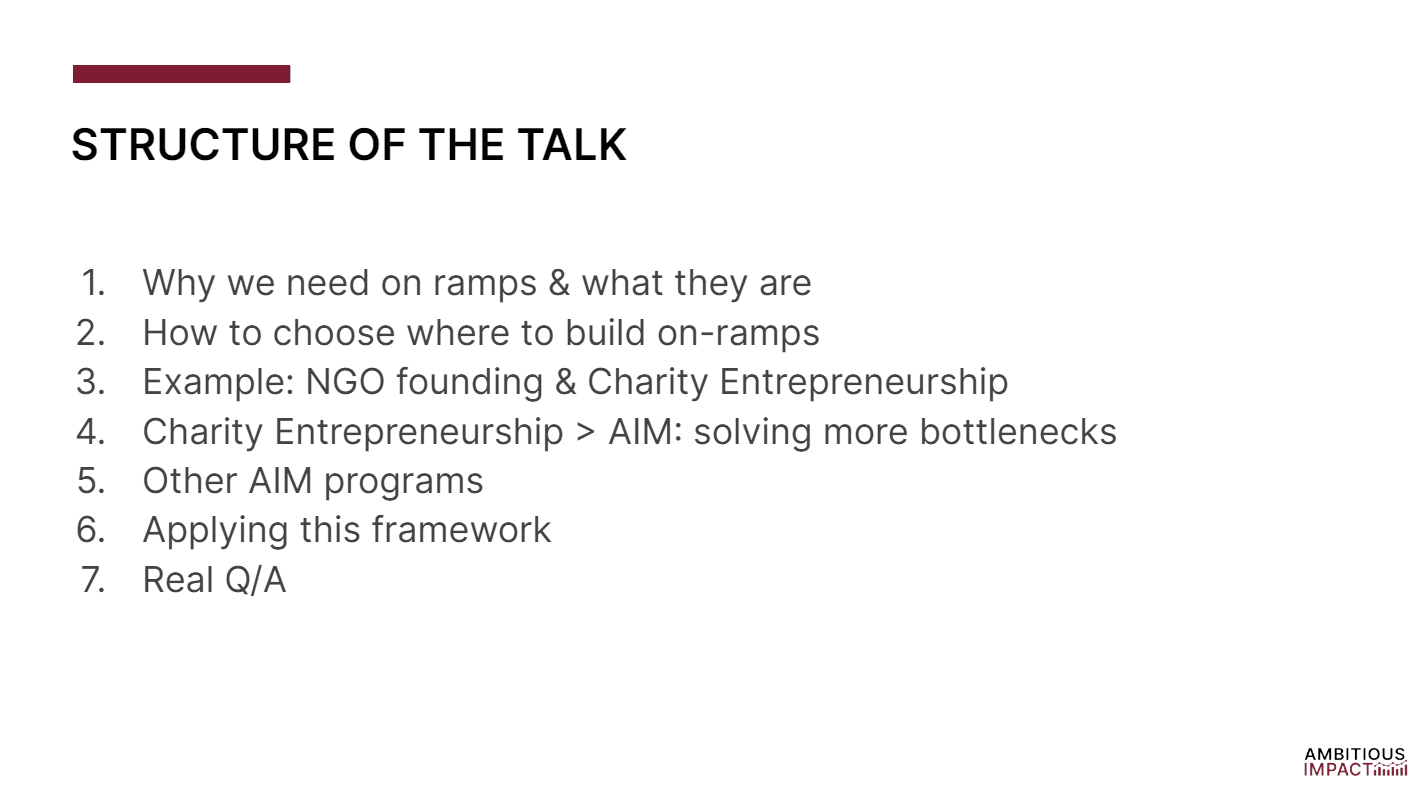
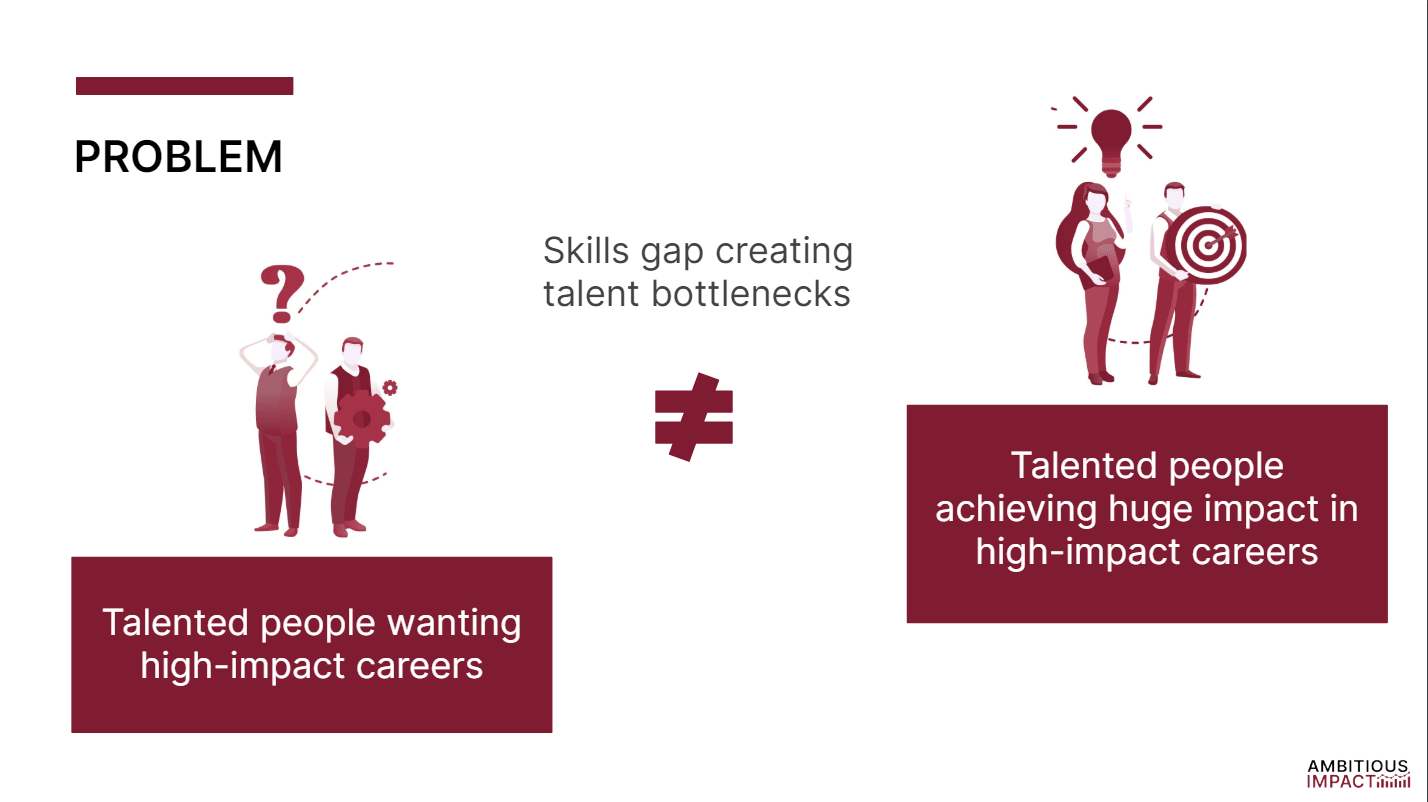

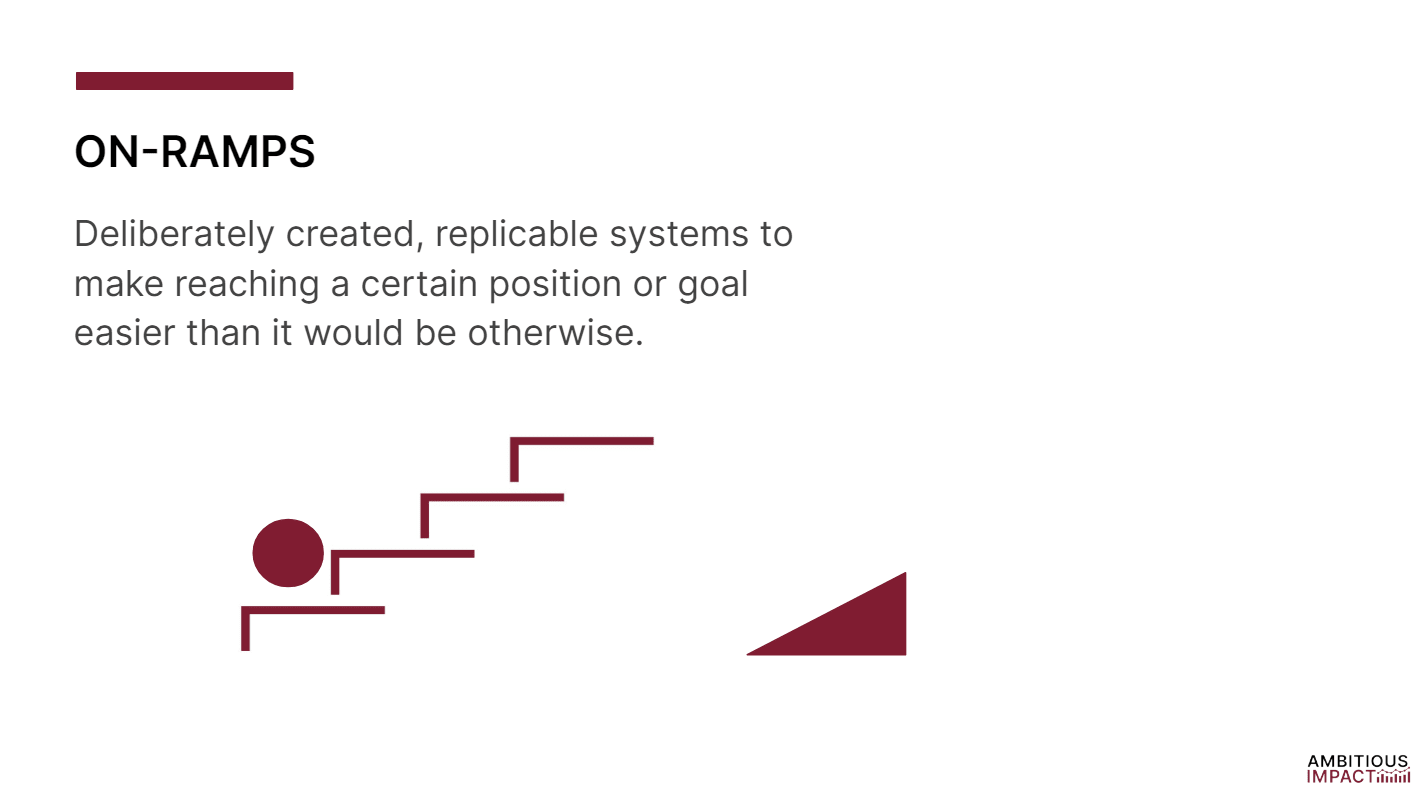
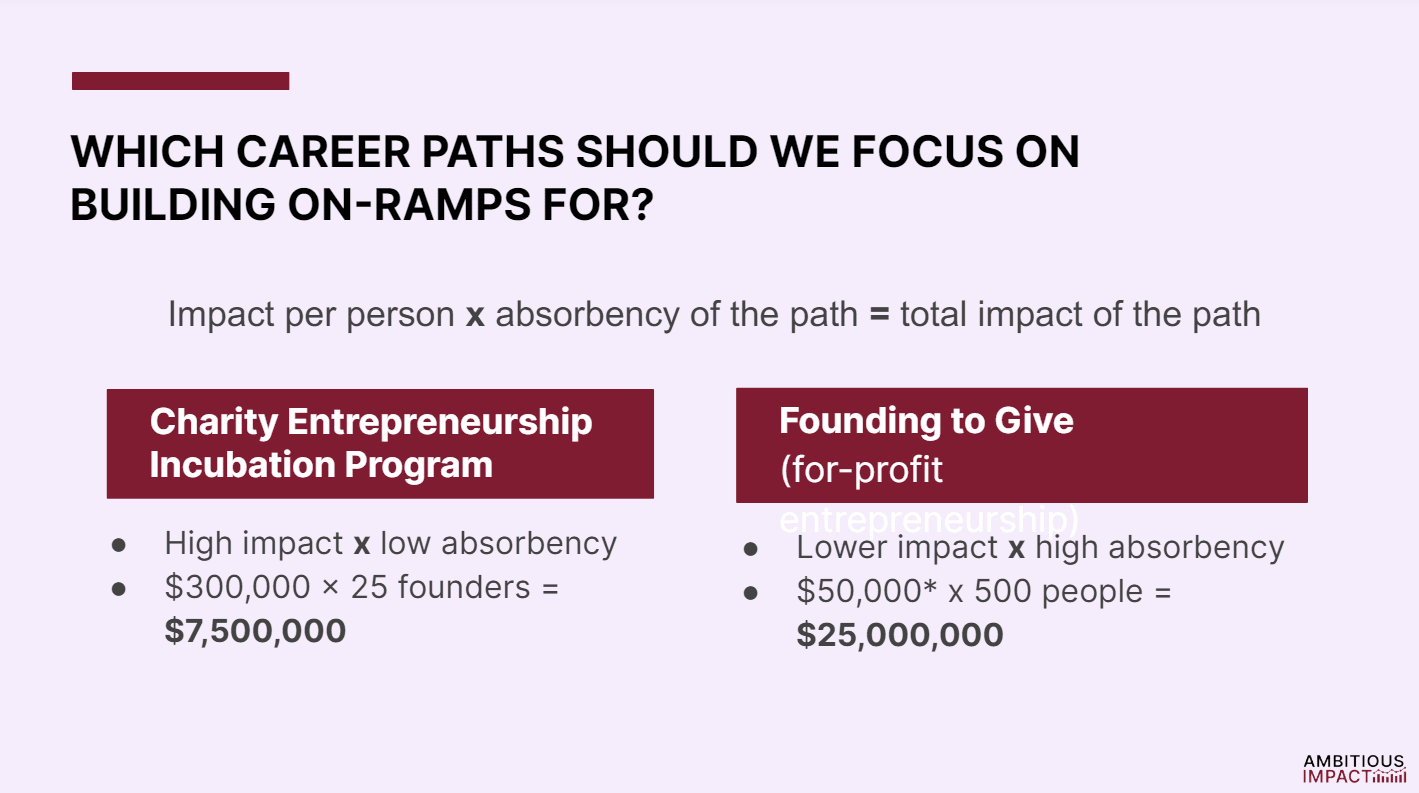
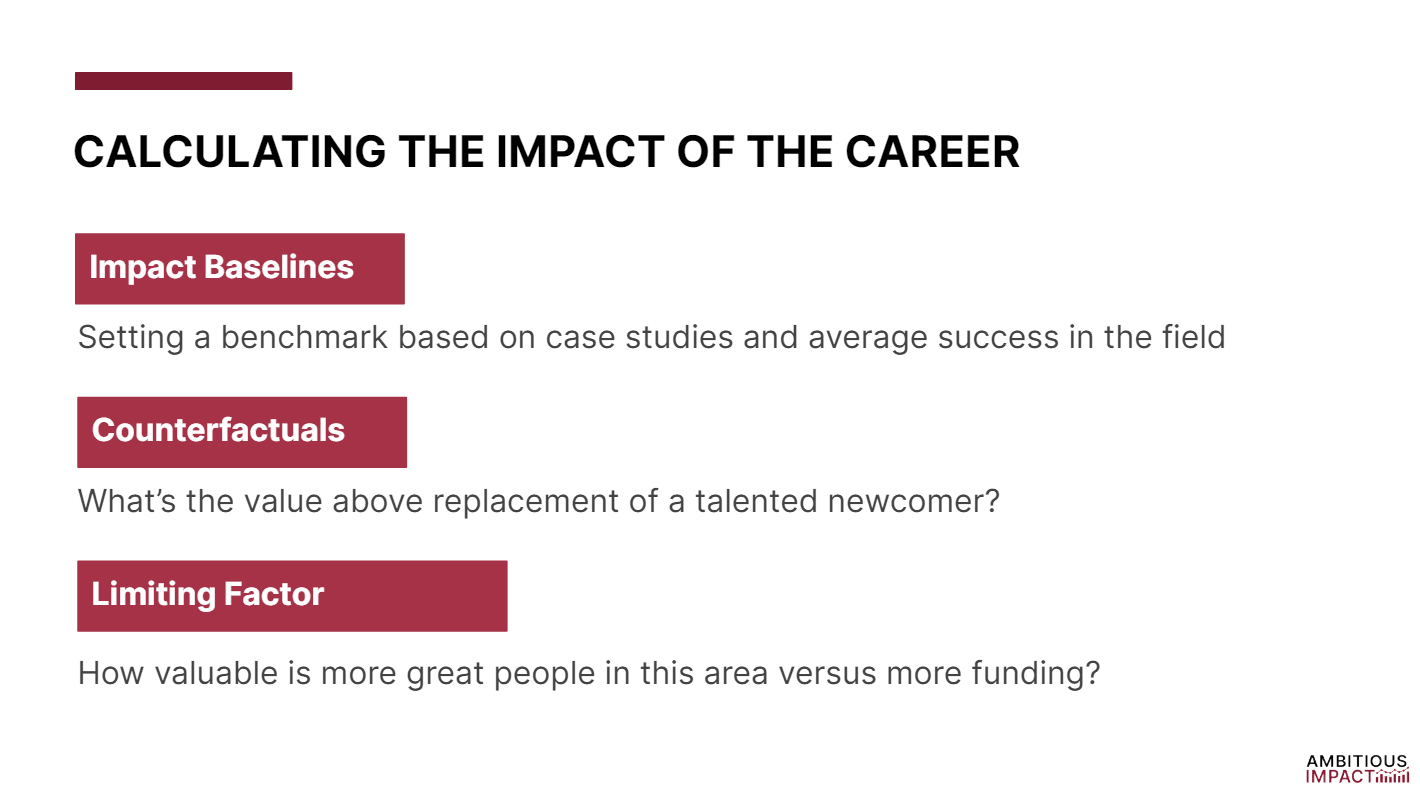

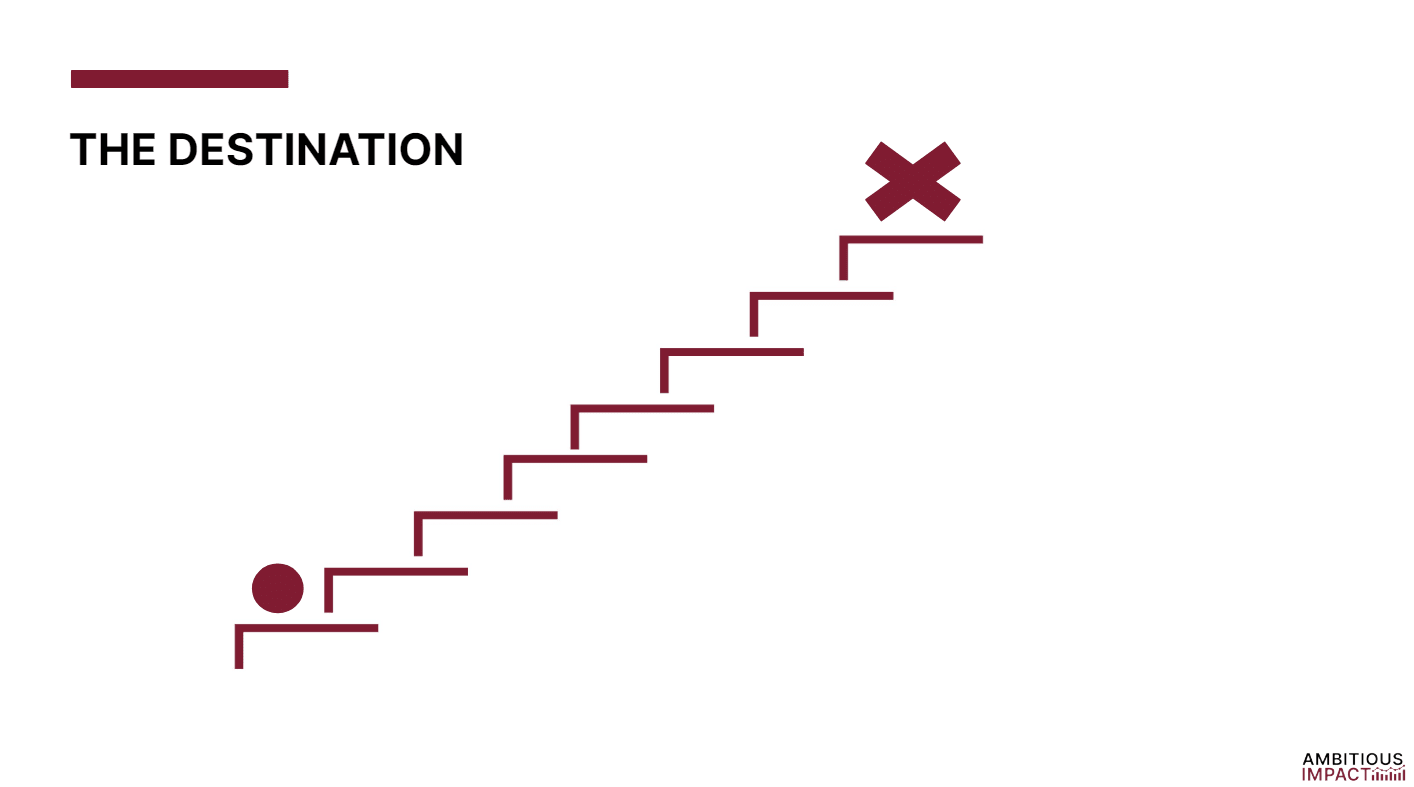
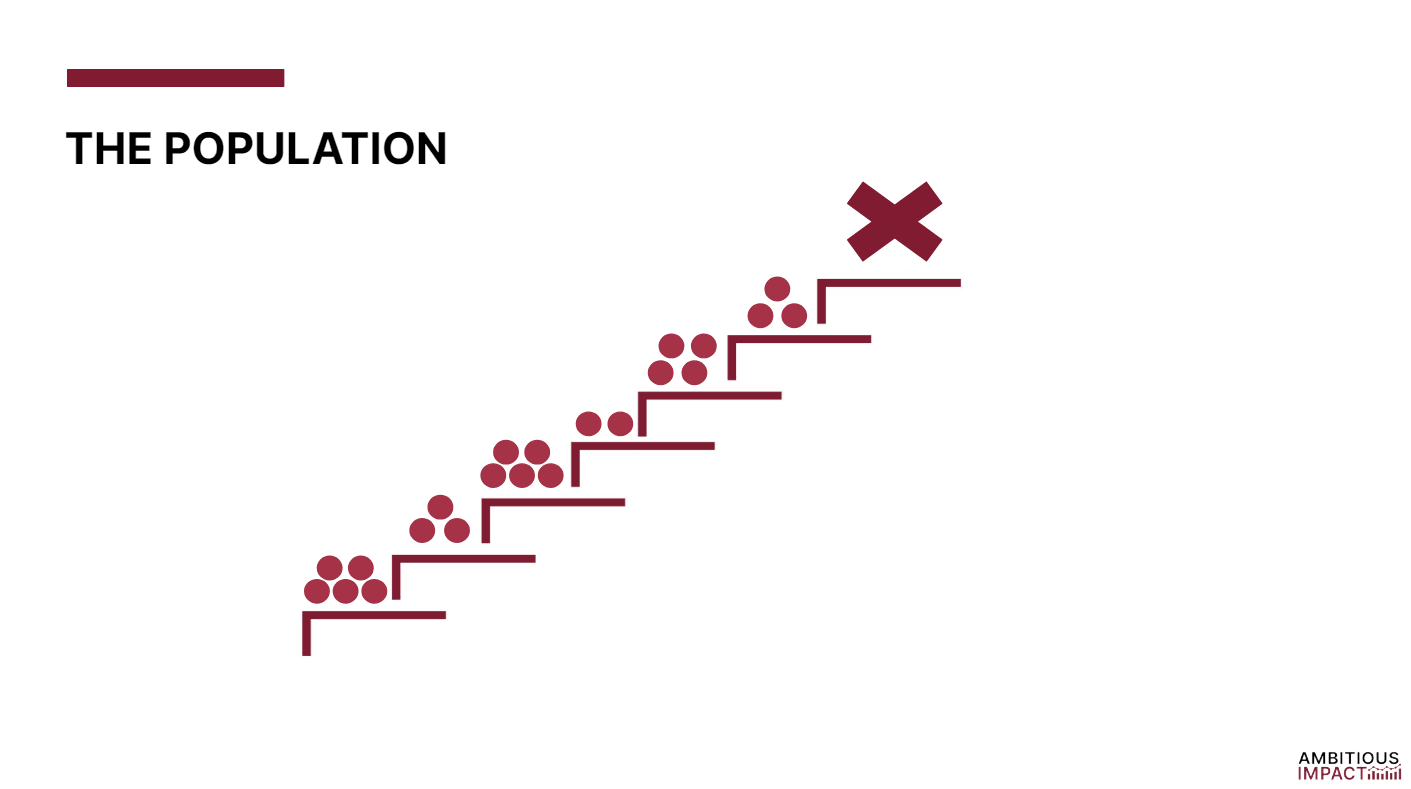
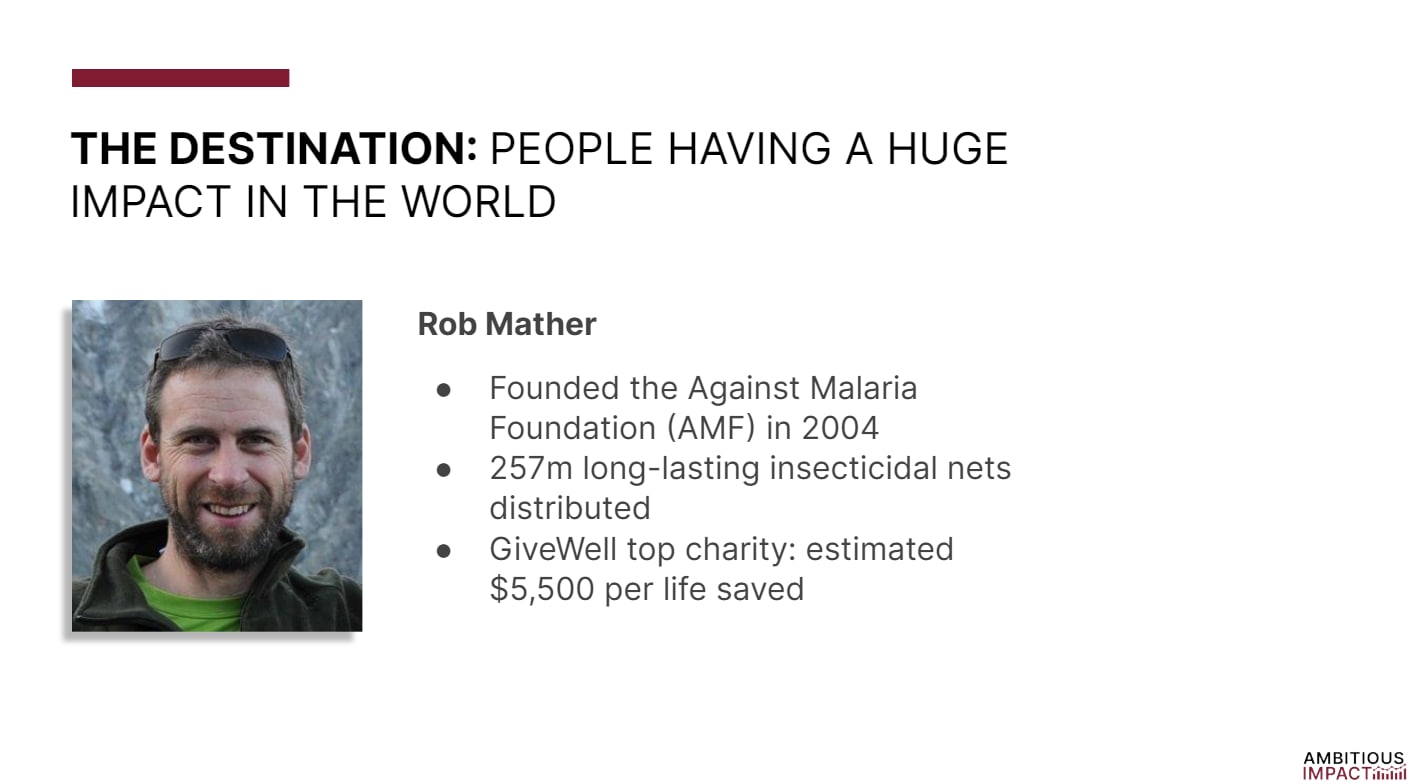
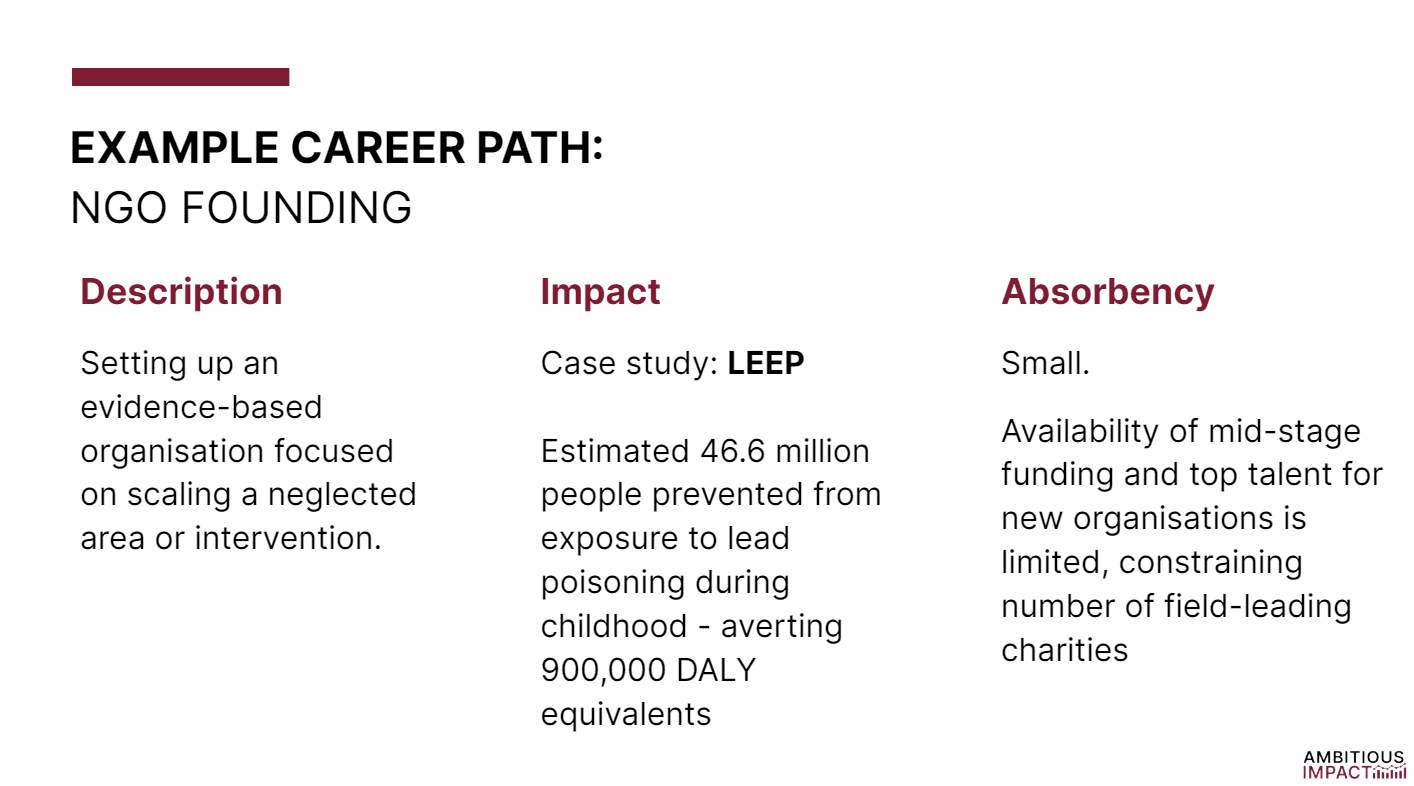
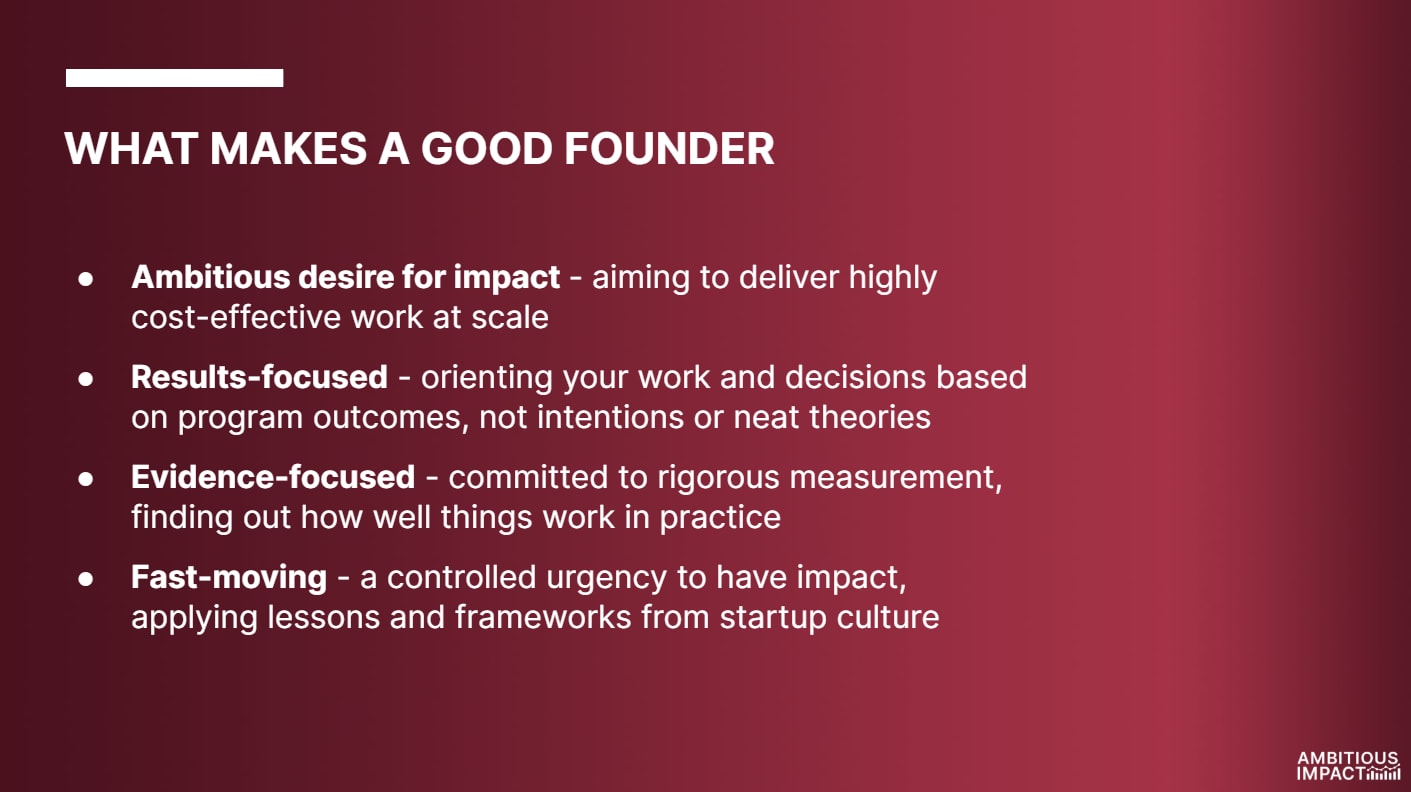
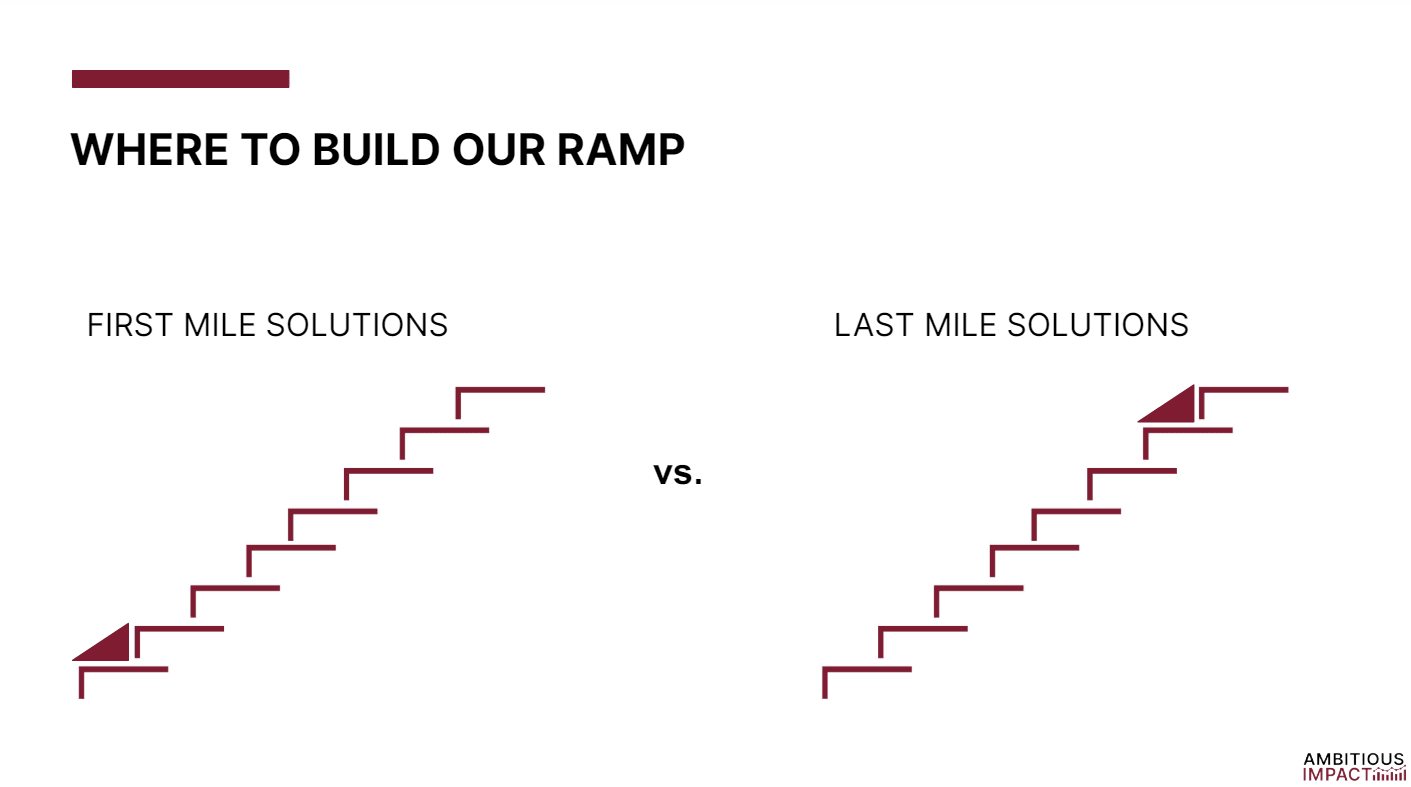
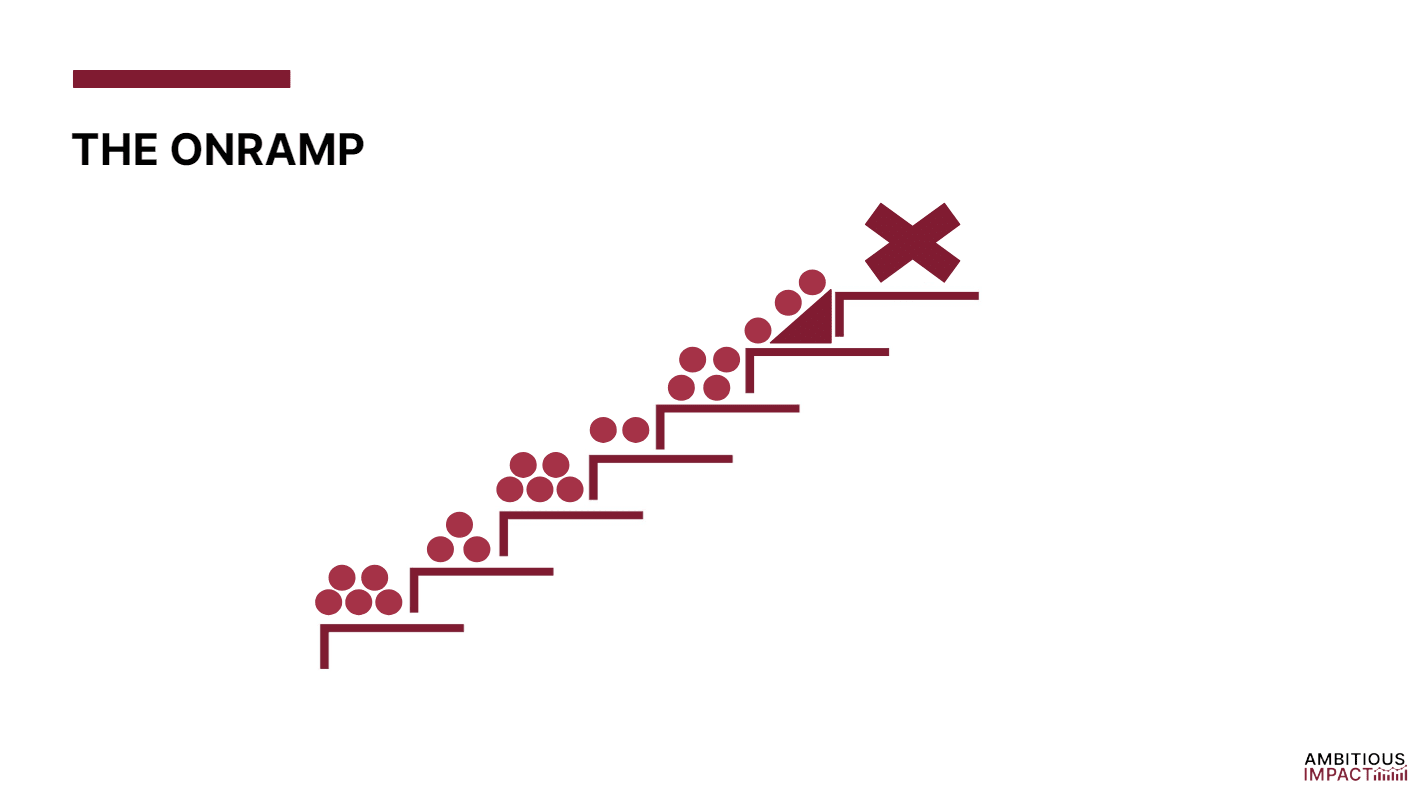
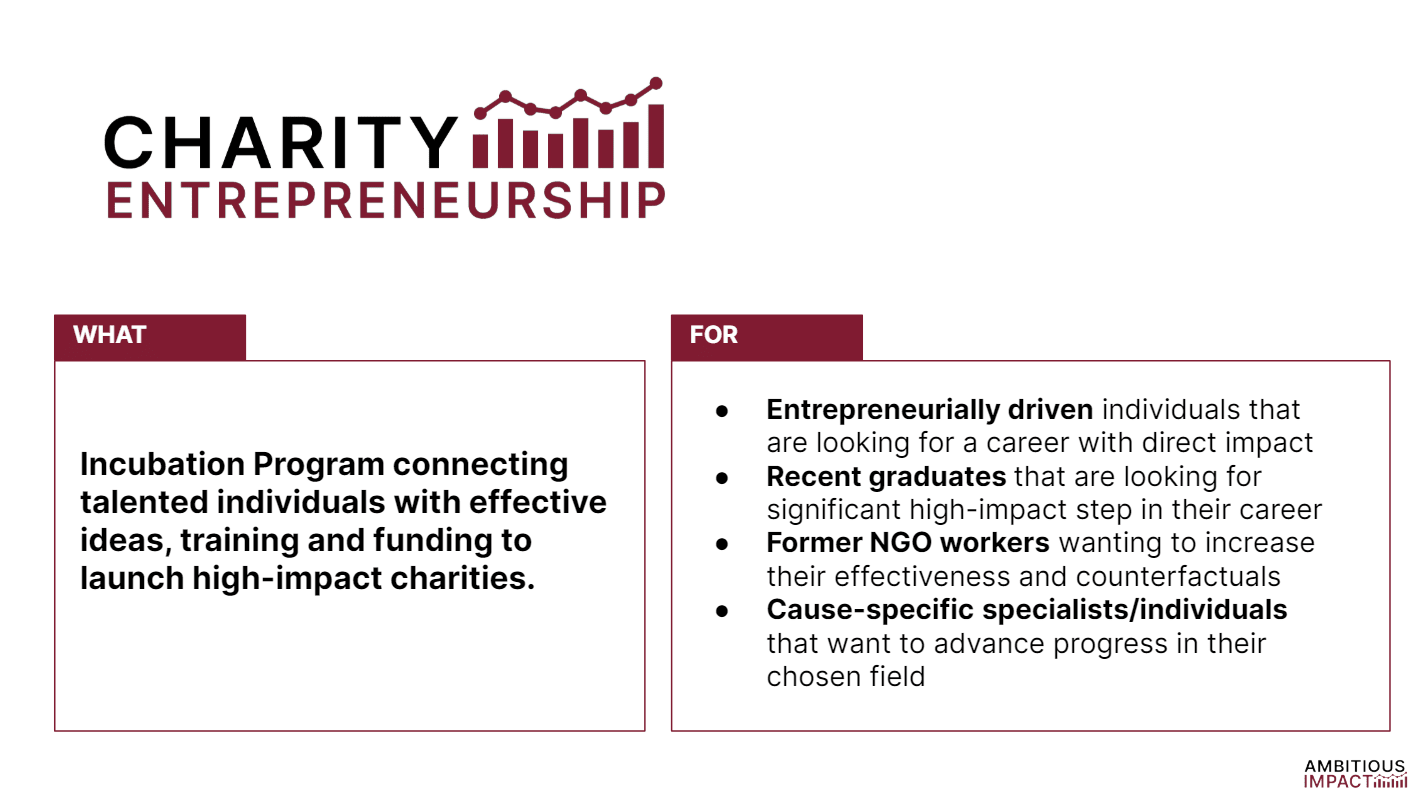
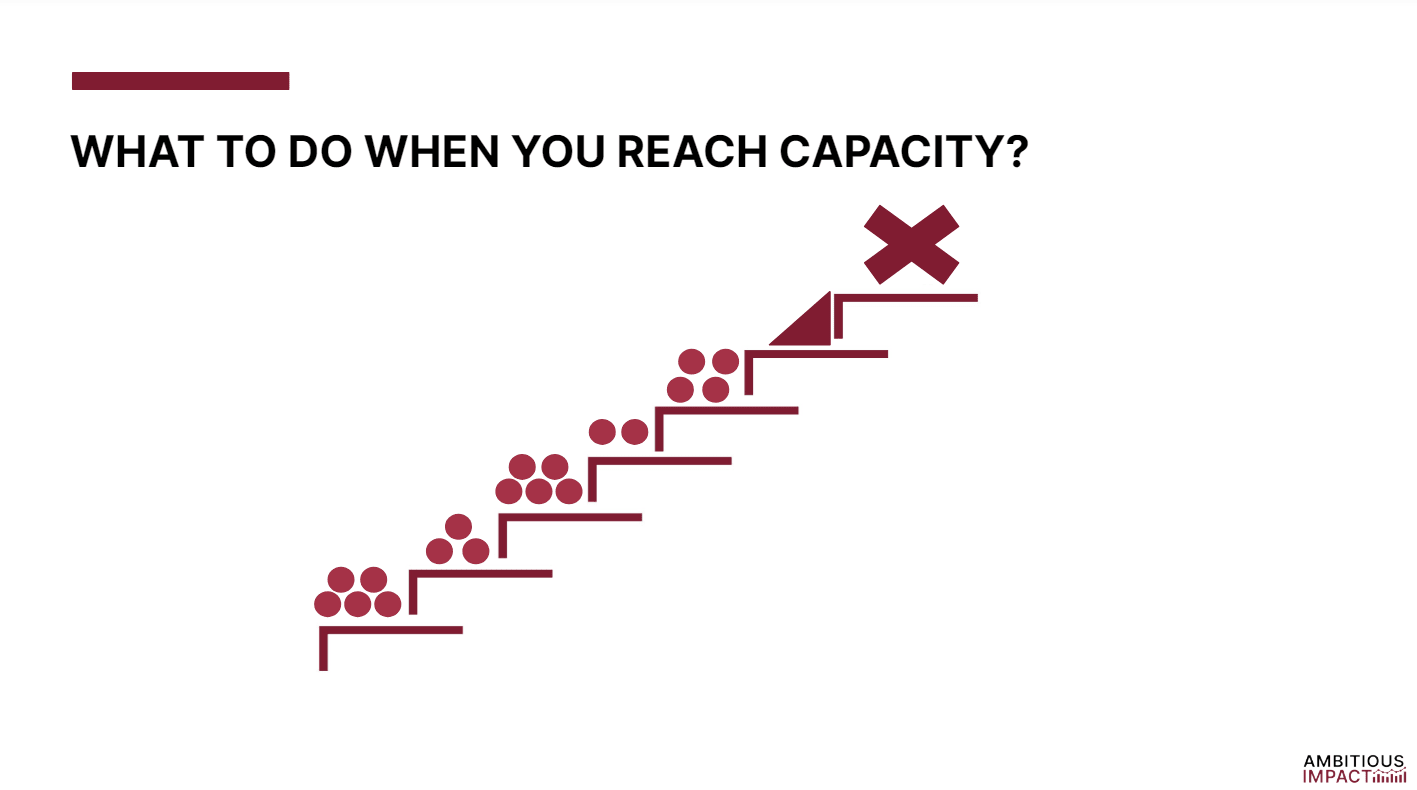


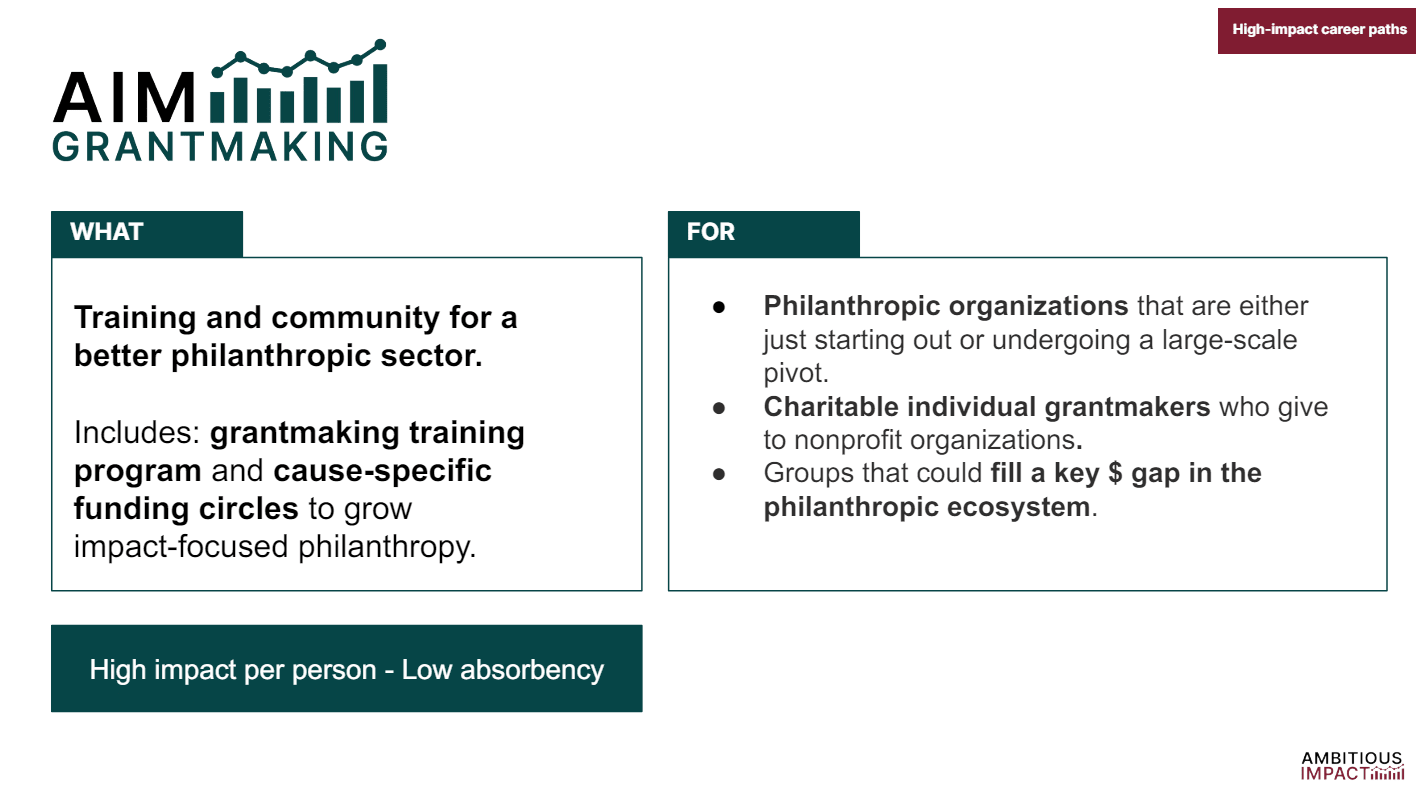
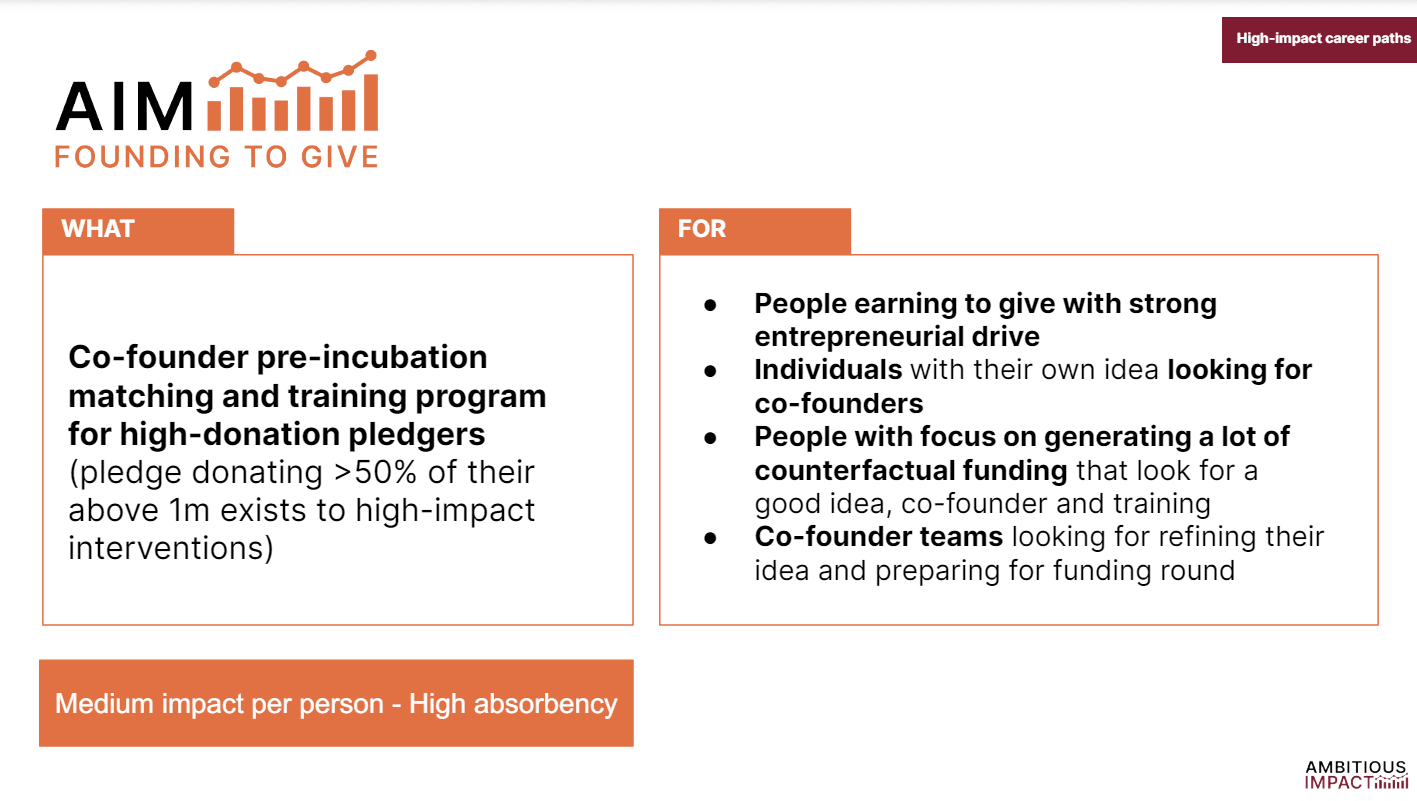
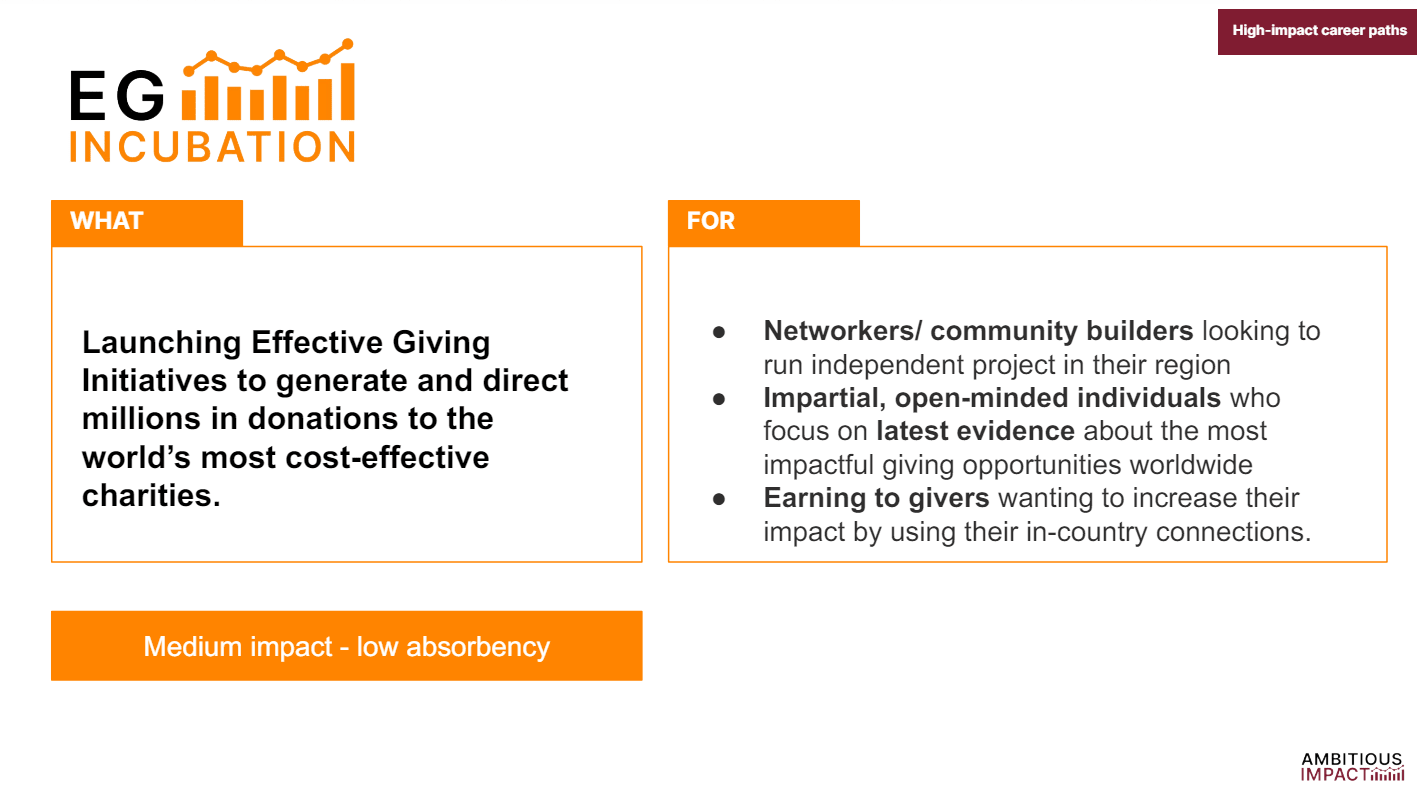
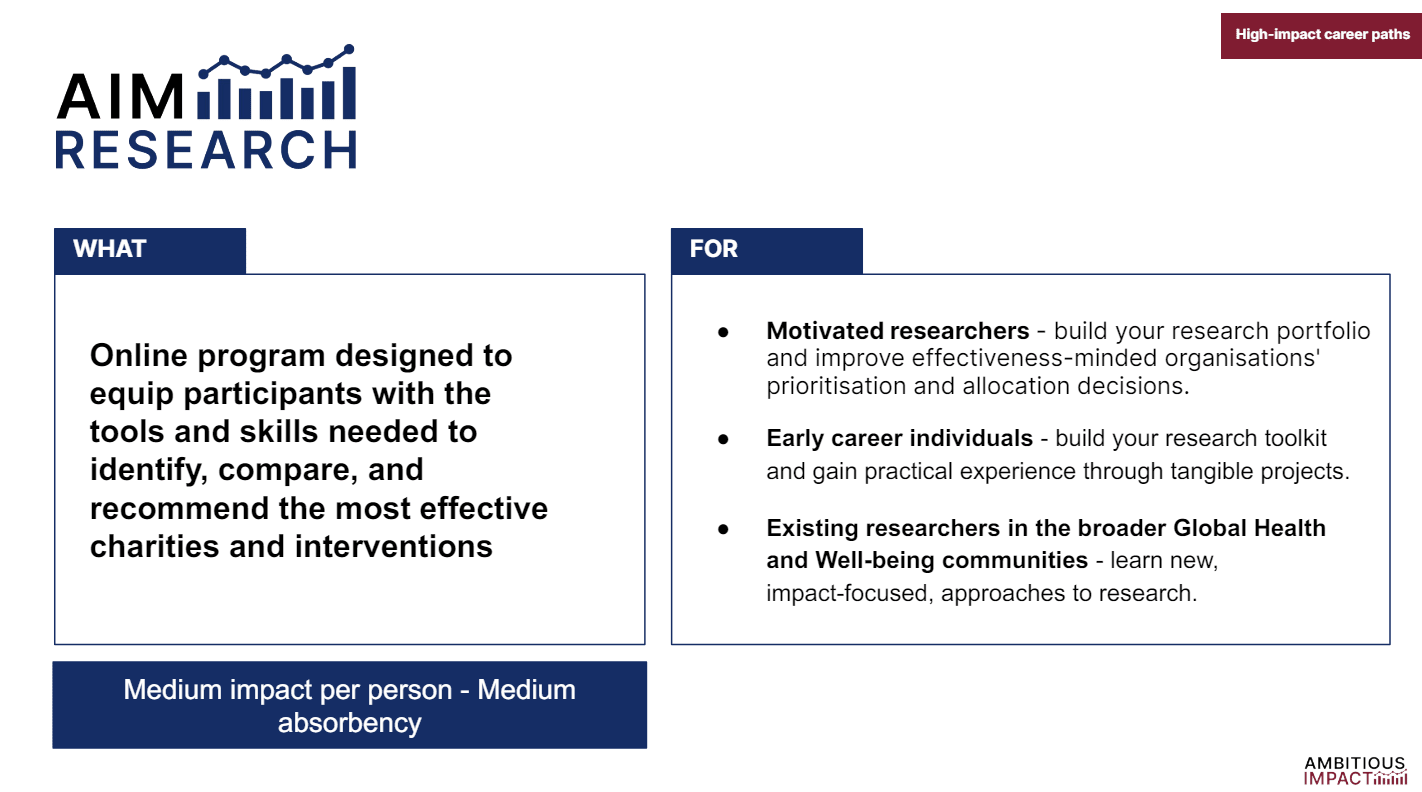
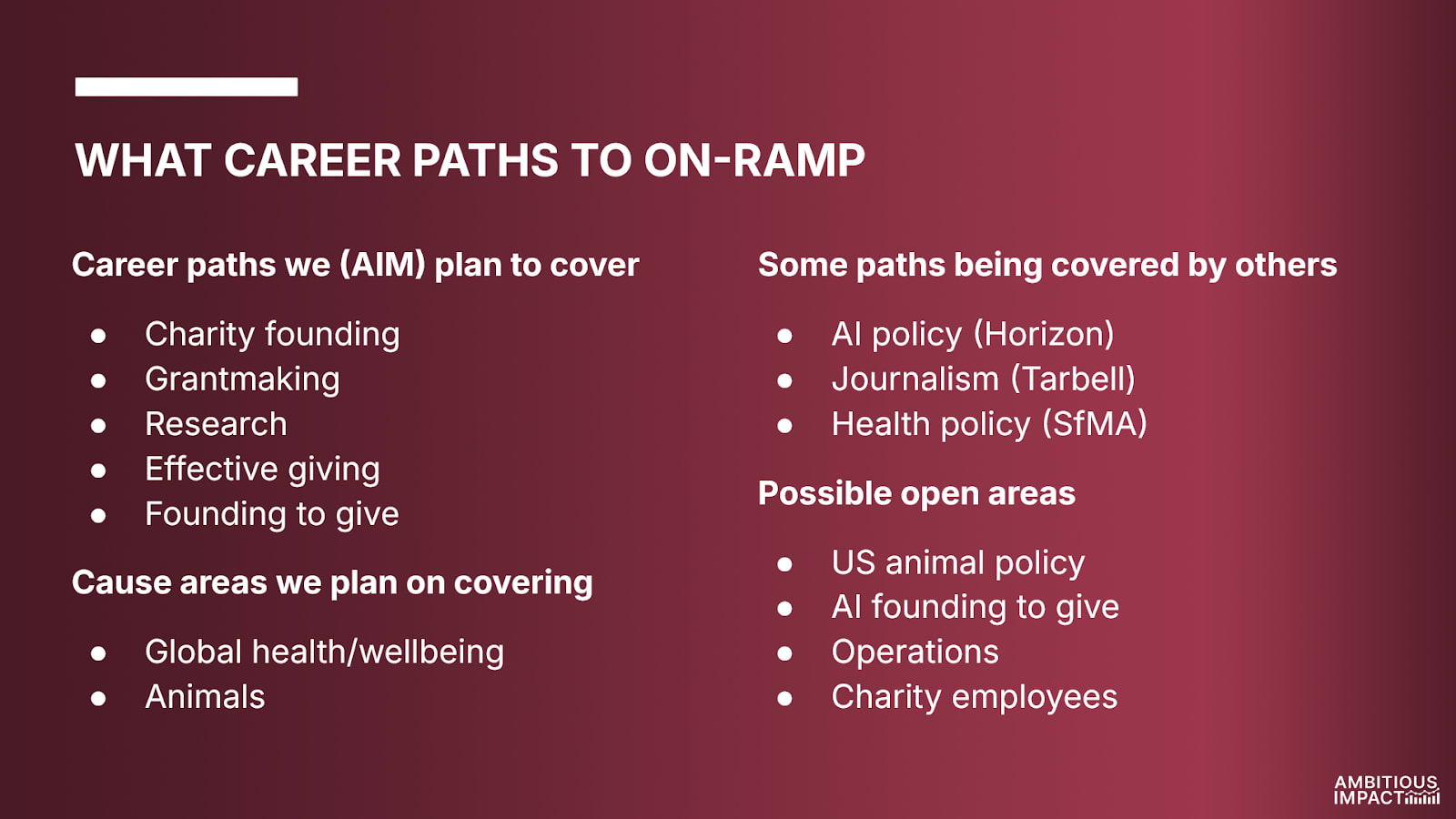
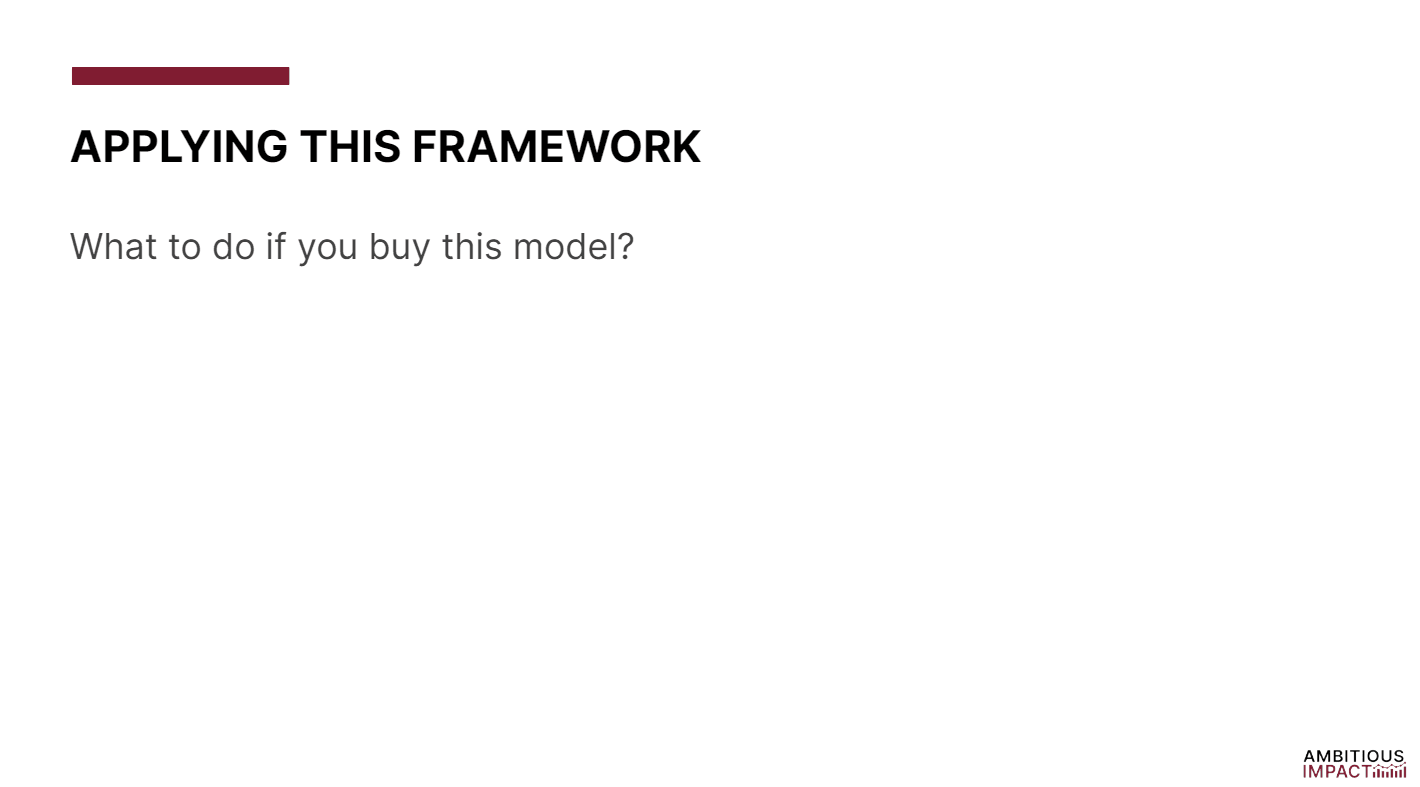

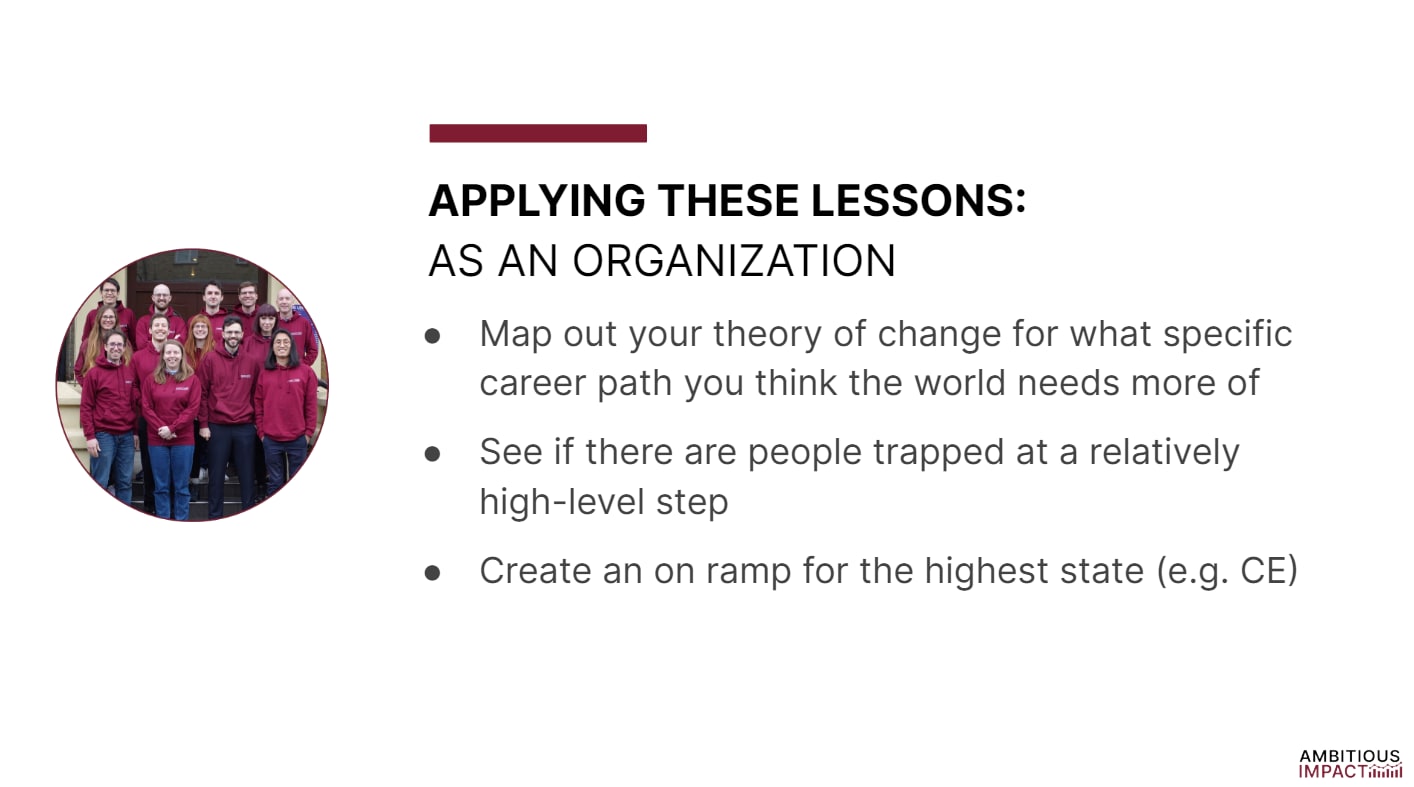
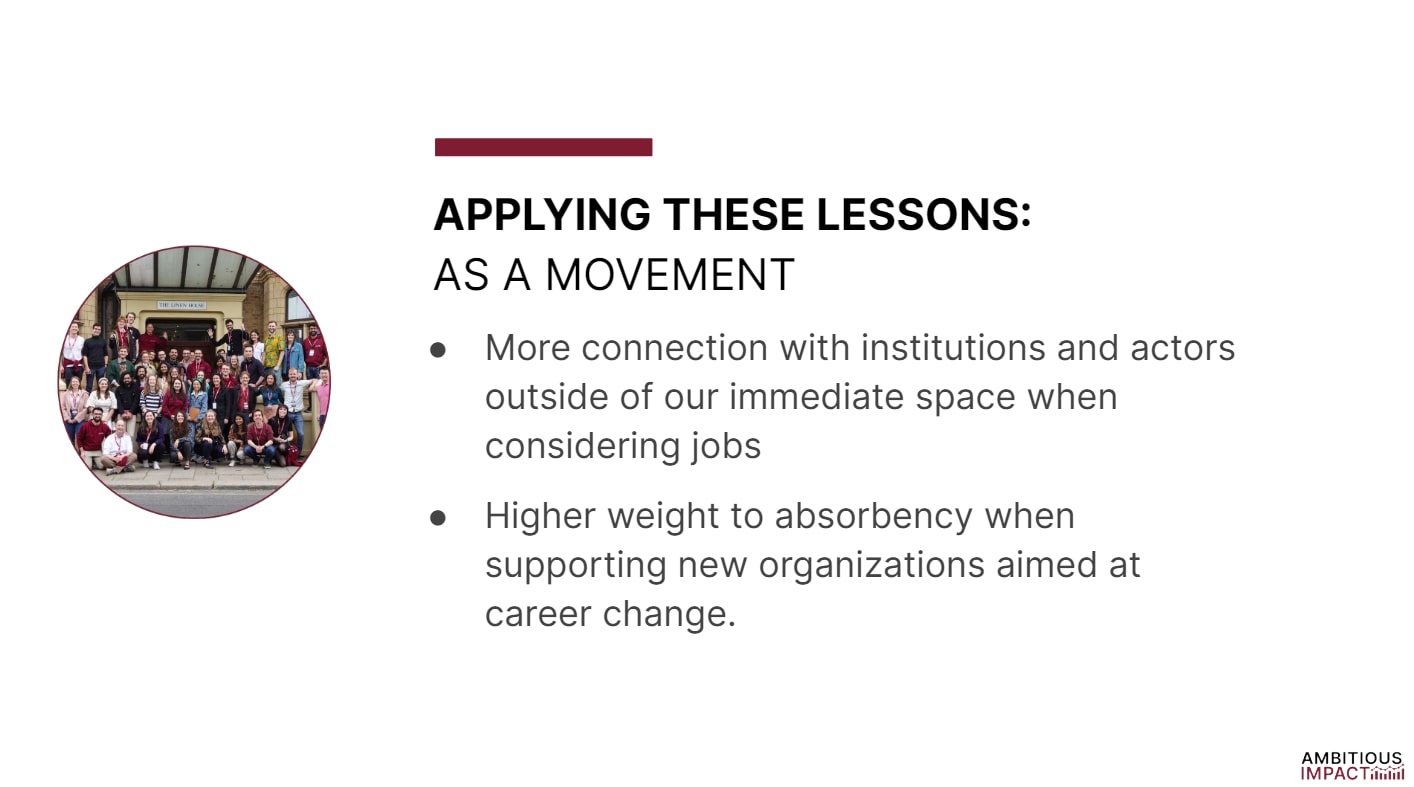
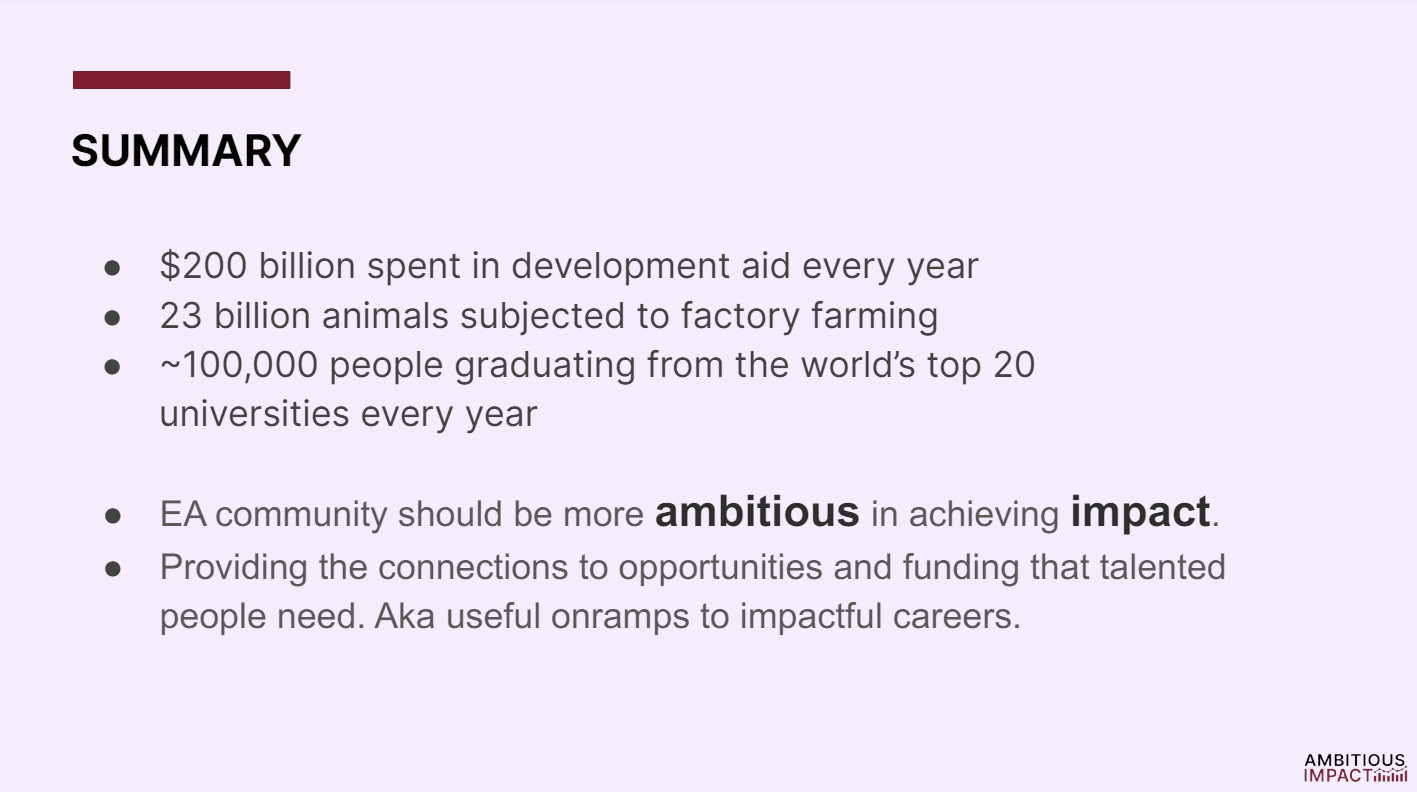
Joey, thanks for this thought-provoking piece on addressing talent bottlenecks with on-ramps, especially through programs like Founding to Give. You rightly highlight that funding is be a limiting factor for scaling impactful initiatives. While Ambitious Impact's program addresses this by encouraging individuals to commit a portion of their earnings to philanthropy, I believe there is still significant untapped potential.
Profit for Good (PFG) businesses—companies that direct their profits to charitable causes—offer a way to overcome this funding bottleneck. PFGs can effectively compete in for-profit markets by capitalizing on a subtle yet powerful advantage: the preference of economic actors (such as consumers, employees, and business collaborators) for supporting charitable outcomes over simply enriching random shareholders. When people are given a choice between two equivalent options, they often favor the one that directs profits toward causes they care about—like saving kids from malaria—rather than increasing the wealth of investors. Even a modest preference for such socially beneficial outcomes can lead to advantages in consumer loyalty, attracting top talent, and forming strategic partnerships.
By not fully exploring how to harness this as a tool and explore the contexts where it could offer the most significant advantages, I think there’s money being left on the table. PFGs could strategically use this natural inclination to gain competitive advantages without compromising business performance. I'm curious if Ambitious Impact has considered integrating this perspective into their programs, as it could align well with the goal of channeling more resources toward effective causes.
Executive summary: Ambitious Impact (AIM) is expanding its programs to create more "on-ramps" for high-impact careers, aiming to help talented individuals overcome final barriers and enter impactful roles across multiple fields.
Key points:
This comment was auto-generated by the EA Forum Team. Feel free to point out issues with this summary by replying to the comment, and contact us if you have feedback.